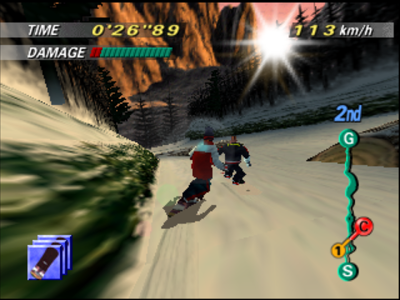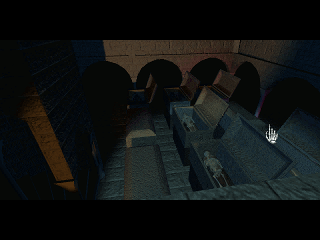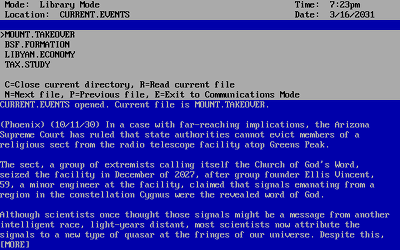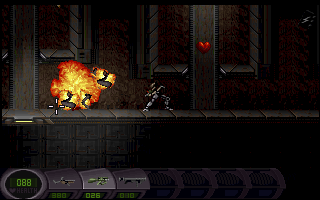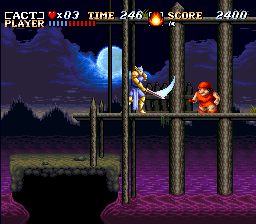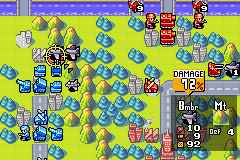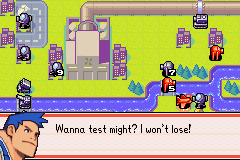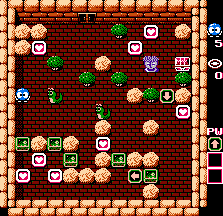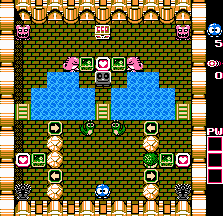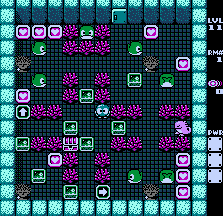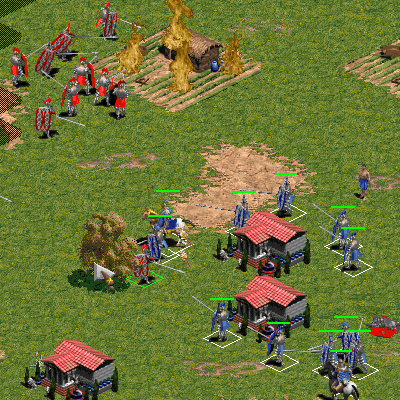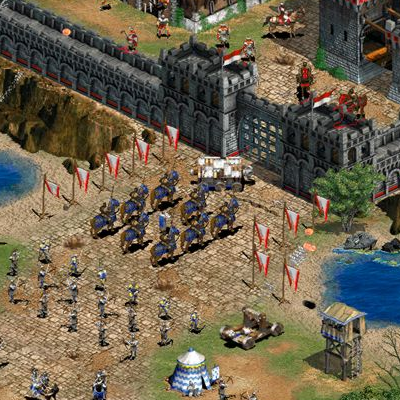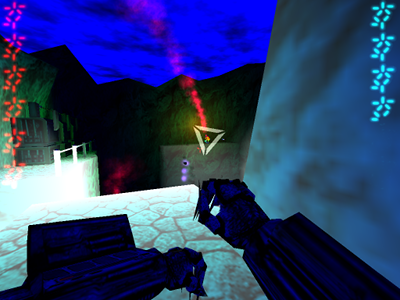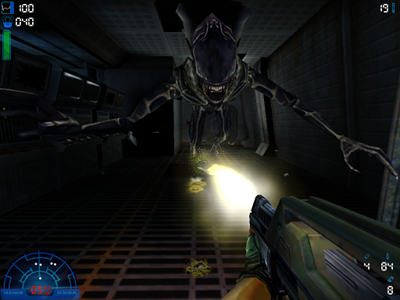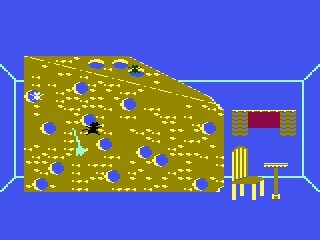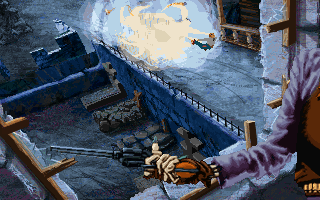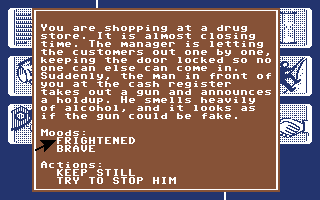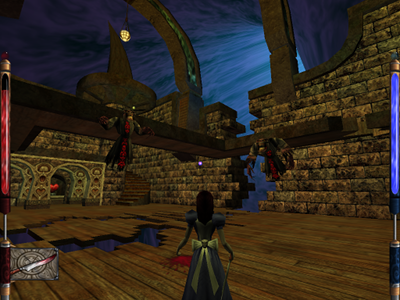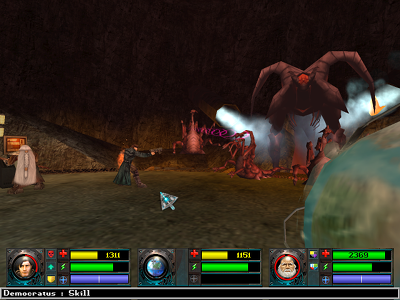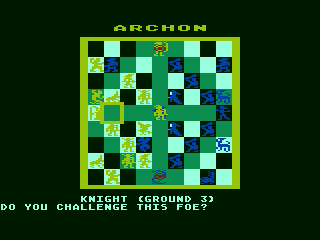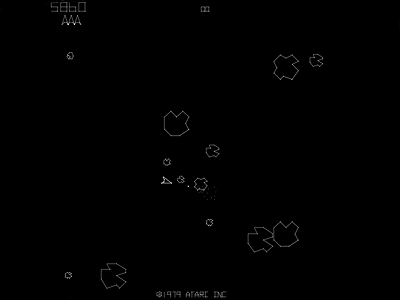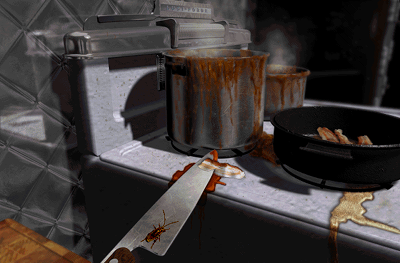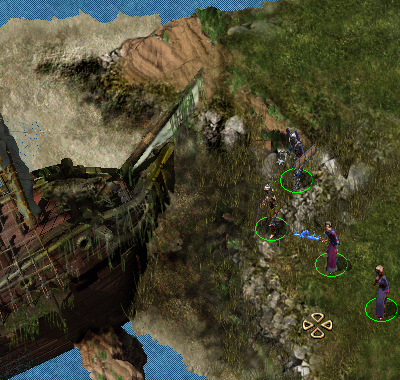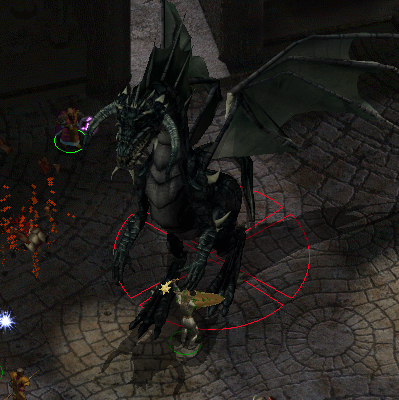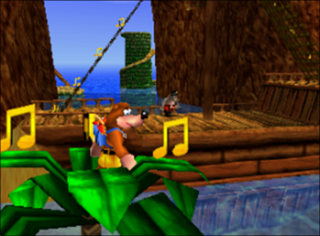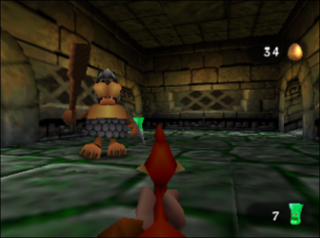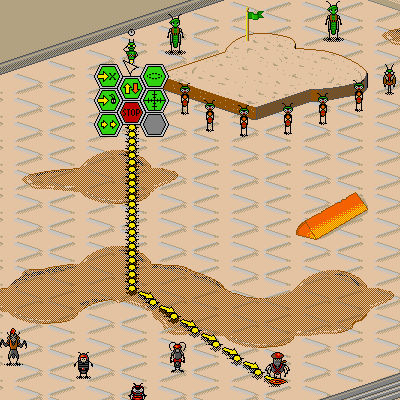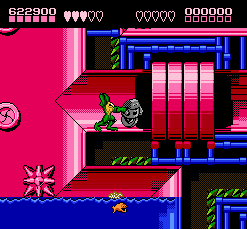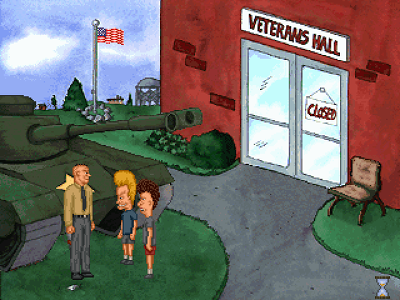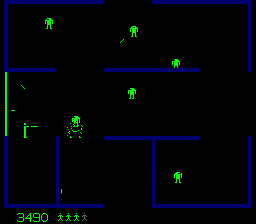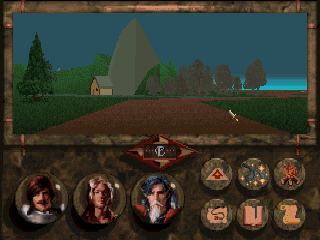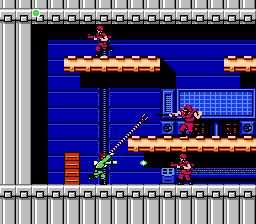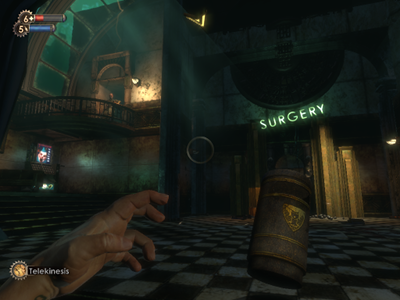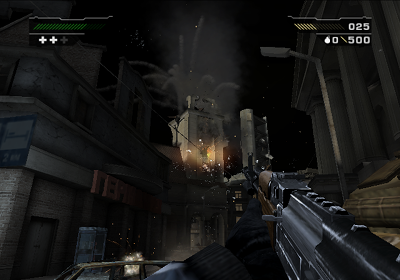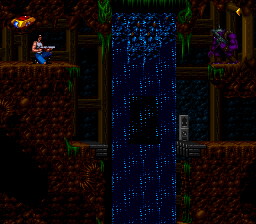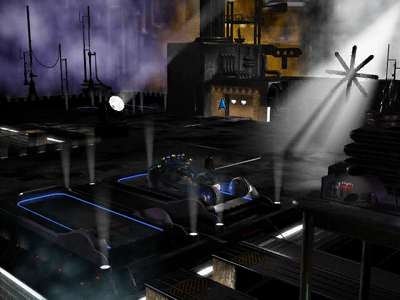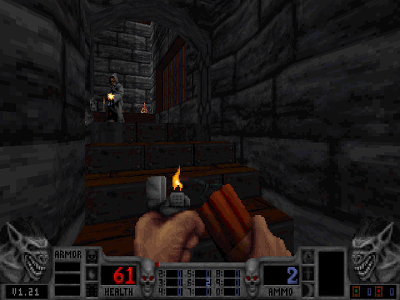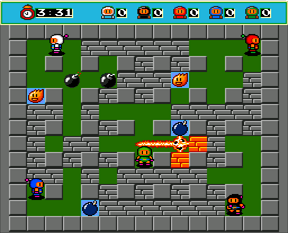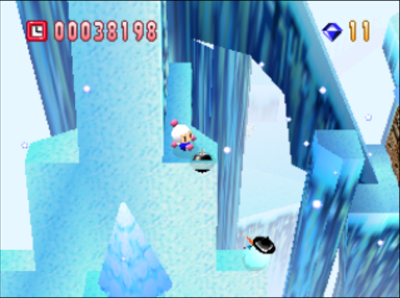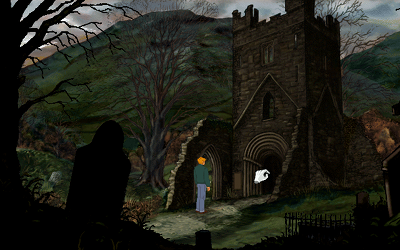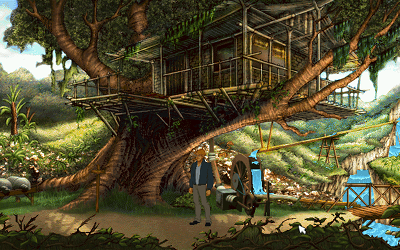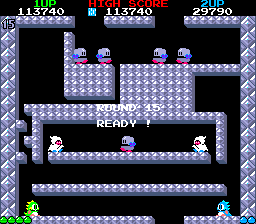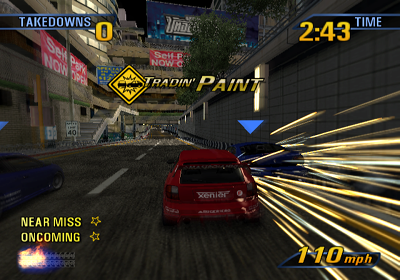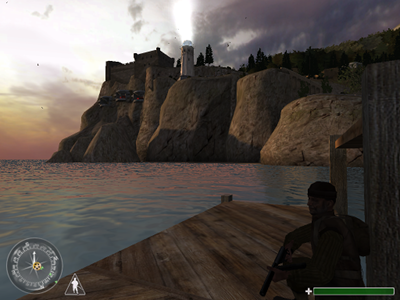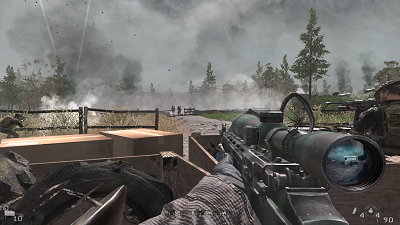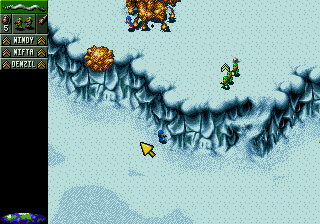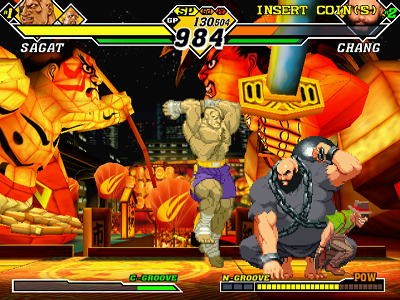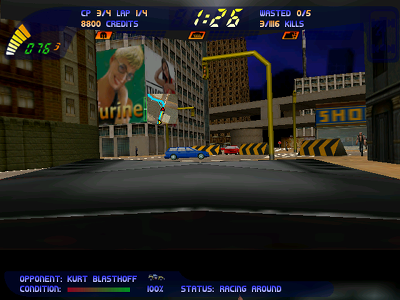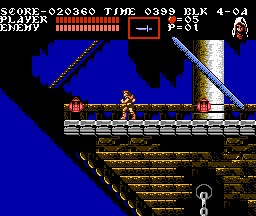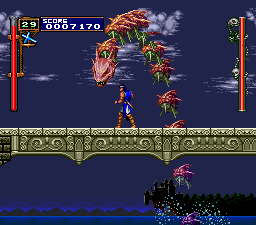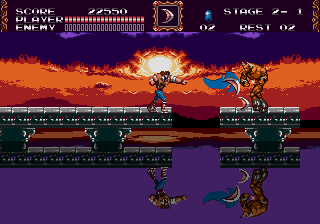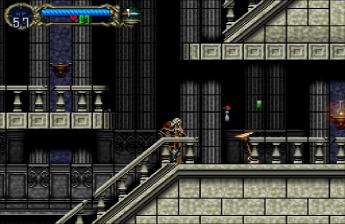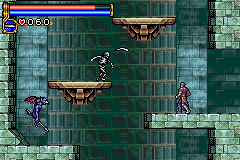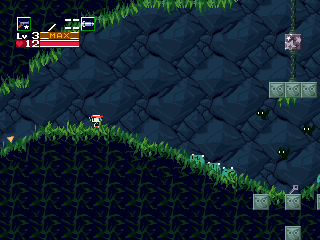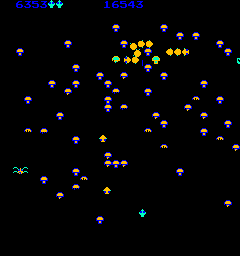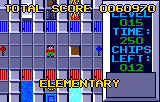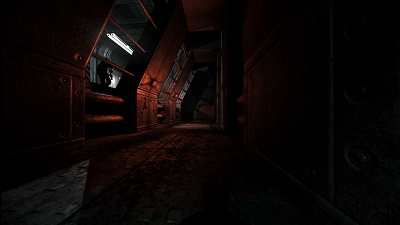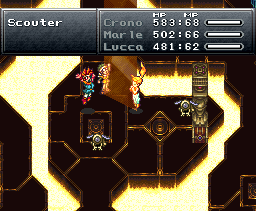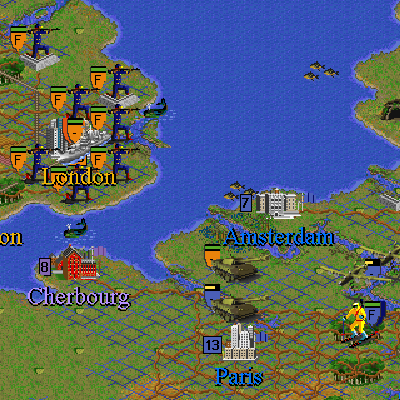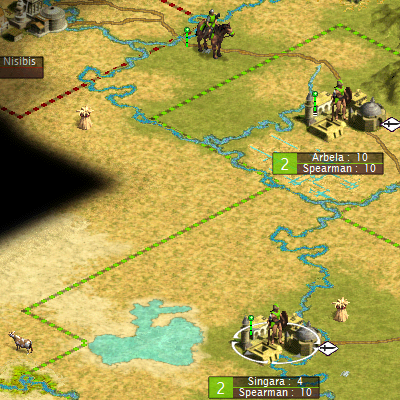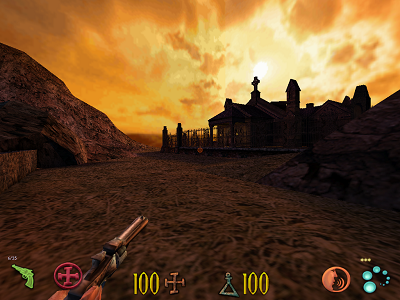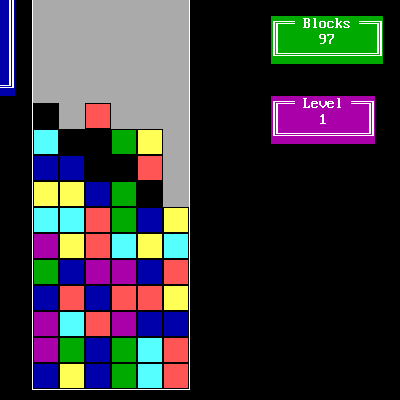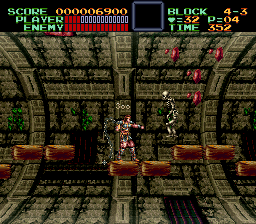Browse the condensed list of capsule reviews here!
Key to the capsule reviews
This is intended to be a near-comprehensive list of every classic, pre-2008 game that I think is still worth playing for general audiences, including their vital stats, and a brief review, meant as a guide to be used to pick games to play. Unlike most review books and websites, everything here is a recommendation. Average, mediocre, and bad games are simply not covered at all.
I won't focus much on games' online experiences, as they are often too volatile to make enduring relevant evaluations. None of the games are going to be too obscure; I may recommend some games you never heard of, but I expect every game here has been played by at least one gamer reading this other than me.
Nearly everything in the boxes can be clicked on to browse by that category. Most of the sections in the capsule review are self explanatory, but some merit explanation.
Stars
Stars in the upper-right corner of the box mark exceptional titles. Even titles without any stars are recommendations, but having a star makes it a stronger recommendation, and more stars make it yet stronger.
1 star games represent roughly 30% of all recommended games.
2 star games represent roughly 12% of all recommended games.
3 star games represent roughly 3% of all recommended games.
Original platform
The system that the game appears to have been originally designed for. This is usually, but not always, the system that it was first released on. The most authentic gameplay experience, unless otherwise noted, will be on that platform. The category link description will include emulation notes when applicable.
Current official platform
The platform(s) that you can acquire the game on today, if current. When marked "official emulation," it's probably good enough, but you can usually do better with unofficial emulation. In other cases, assume this is my preferred way of playing the game, unless otherwise noted.
Optimization notes
This is important! When this section is present, it indicates that there's something you need to do to optimize the gameplay experience, beyond simply obtaining and playing the game out of the metaphorical box.
In any of these cases, clicking will link to further notes or instructions. For instance, DOS games composed for the MT-32 need special work if you want the music to sound right, so for these games, this section will indicate that status and link to instructions on how to properly use or emulate an MT-32.
Key people
Not meant to be exhaustive, but mainly as an interesting browsing option. This section will list the most prolific creative contributors to the game, with Wikipedia as a guideline to determine who is "prolific" enough to be listed.
Capsule reviews
A B C
| 1080° Snowboarding
|
| Companies
|
Nintendo EAD, Nintendo
|
| First release date
|
Aug 13, 1998
|
| Original platform(s)
|
N64
|
| Current official platform(s)
|
Official emulation: VC
|
|
Racing
|
|
|
An outstanding physics model, spot-on controls, realistic aesthetic, and crisp, detailed visuals make this game work, and it stands out as one of the few successful snowboarding titles. Different densities of snow and ice affect your board's handling, and the difference in friction can be felt in subtle rumble effects. The racing modes are more compelling than the trick modes, and only the former allow split-screen multiplayer.
|
|
| Key people
|
Shigeru Miyamoto
|
| The 7th Guest
|
| Companies
|
Trilobyte, Virgin Interactive
|
| First release date
|
1993
|
| Original platform(s)
|
DOS
|
| Current official platform(s)
|
GOG
|
| Optimization notes
|
ScummVM, General MIDI
|
|
Adventure
|
|
|
The first real killer app game for CD-ROM drives remains a dark, creepy, and sometimes hilarious experience, even as its subject material may seem tame and its production values hokey in retrospect. You explore a mansion full of figurative and literal ghosts, and lots and lots of puzzles, most of which are classical brainteasers with macabre twists. A very helpful map shows you not only where you have yet to explore, but also which rooms still contain unsolved puzzles, and visiting the mansion's library will reveal increasingly specific hints to your most recently attempted puzzle. These features make it more casual-friendly than Myst, though be warned, a few puzzles are quite nasty! Much of the story is conveyed through FMV actors who are mostly incompetent, though Robert Hirschboeck as your host Stauf stands out as especially hammy and also menacing. Sound design is phenomenal and use of FMVs seamless, which is all the more impressive considering this was one of the first games to be designed from the ground up for multimedia systems. Was also a killer app for Phillip's ill-fated CD-i console.
|
|
| Key people
|
George Sanger, Stephen Clarke-Willson, Graeme Devine, Matthew Costello, Rob Landeros
|
A
| A Mind Forever Voyaging
|
| Companies
|
Infocom
|
| First release date
|
1985
|
| Original platform(s)
|
DOS
|
| Optimization notes
|
Z-Machine
|
|
Interactive fiction
|
|
|
A unique Infocom interactive fiction title, casting you as an AI designed to predict the future, by exploring and observing simulated, Matrix-like realities. Emphasizes exploration and observation over puzzles, but realizes "interactive fiction" in a way nothing else really has. Your role as an AI is cleverly reinforced by an interface that allows suspending, resuming, and resetting the simulations, and functions such as reading news feeds and checking facility monitors when out of the simulation. Infocom's most serious and most politically sensitive game; it's devastatingly well written, with detailed descriptions of every scene and object, stories behind every building, landmark, and person, even including a paperback novella good enough to be published separately.
|
|
| Key people
|
Steve Meretzky
|
| Abuse
|
| Companies
|
Crack dot Com, Electronic Arts
|
| First release date
|
Aug 1995
|
| Original platform(s)
|
DOS
|
| Optimization notes
|
Freeware source port, General MIDI
|
|
Run & gun platformer
|
|
|
A spectacularly dark run & gun platformer with intuitive mouse-based controls, smooth animations, plenty of variety in weapons and monsters, and lots of secrets and puzzles. An included level editor is remarkably advanced for its time. The classic sprawling, secret-filled 2D level design is a throwback to the heyday of Apogee's DOS platformers, but with a slick presentation, snazzy mechanics, and violence fitting for a post-Quake world. The sole product of Crack dot Com, a short lived studio founded by one of the programmers behind Doom and Quake. Abuse-SDL now runs natively in Windows, with high color support and some other quality of life features.
|
|
| Key people
|
Robert Prince, Dave Taylor
|
| ActRaiser
|
| Companies
|
Quintet, Enix
|
| First release date
|
Dec 16, 1990
|
| Original platform(s)
|
SNES
|
| Current official platform(s)
|
Official emulation: VC
|
|
Sidescrolling platformer, Economic sim, Action/adventure
|
|
|
Quintet's debut is an interesting mashup of disparate gameplay styles. In between stages of hack & slash platforming, you are tasked with rebuilding the previously conquered world into a prosperous city-state, shifting the gameplay to an overhead perspective mode that has often been compared to Populous and Sim City. These sequences are simplistic and perhaps too easy, but innovative and fun enough to elevate ActRaiser from a competent sidescroller to an SNES classic. The North American release tones down religious symbolism in accordance with NOA's policies. Followed by a disappointing sequel that omits the city building aspect.
|
|
| Key people
|
Yūzō Koshiro
|
| Advance Wars
|
| Companies
|
Intelligent Systems, Nintendo
|
| First release date
|
Sept 10, 2001
|
| Original platform(s)
|
GBA
|
| Current official platform(s)
|
Official emulation: VC
|
|
War strategy
|
|
|
Intelligent System's third entry in the long-running Famicom Wars, but the first to be released outside Japan. Intuitive, quick-tempo turn-based gameplay, with clear and fairly simple rules regarding each unit's ability to move, attack, and defend, that nonetheless enable complex, almost chess-like tactics. The campaign is very well paced, and the preceding tutorial mini-campaign does an excellent job of teaching the rules and encouraging tactical thinking. The fact that Intelligent Systems managed to devise mechanics and controls so well suited to a handheld is an achievement in itself. Nintendo's trademark cutesy-ness and bright, rounded aesthetic is expected but at odds with the all too plausible war setting. Multiplayer maps with pre-deployed units move faster than traditional base-building maps, which tend to drag as one side slowly loses to attrition. A smash hit in North America, unexpected by Nintendo, which led to future international releases of Fire Emblem, another long-running, formerly Japan exclusive turn-based strategy series.
|
|
| Advance Wars 2: Black Hole Rising
|
| Companies
|
Intelligent Systems, Nintendo
|
| First release date
|
June 23, 2003
|
| Original platform(s)
|
GBA
|
| Current official platform(s)
|
Official emulation: VC
|
|
War strategy
|
|
|
A decent, slightly bloated follow-up to Advance Wars. AI is much improved, Super CO powers add new tactical options, missile silos can turn the tide when used wisely, and Neotanks can either be a welcome addition or they can turn every game into a Neotank race, depending on the map played. Despite the AI improvements, the campaign never gets quite as challenging as AW1's does, and the story and dialog is even sillier, lacking both gravitas and self-awareness. Suggestion - play the original first, and think of AW2 as an expansion pack if you want more.
|
|
| Adventure
|
| Companies
|
Atari, Inc.
|
| First release date
|
1980
|
| Original platform(s)
|
Atari 2600
|
| Current official platform(s)
|
Official emulation:
Mobile, Steam (Atari Vault), PS4 Store, XB1 Store
|
|
Action/adventure
|
|
|
Possibly the first example of an action-adventure video game, and often voted as the best game on the Atari 2600 system. As A Square, you must search the kingdom for a magical chalice and safely return it to your castle, but beware of the bothersome bat and the anseriform dragons. An incredible technical achievement; most 2600 games contained the entire action on a single, unmoving screen, and this has 31 different screens arranged nonlinearly, one of which contains the very first video game Easter egg. It's a short game, but enjoyable while it lasts, and an element of randomness (especially on game mode 3) adds some replay value.
|
|
| Key people
|
Warren Robinett
|
| The Adventures of Batman & Robin
|
| Companies
|
Clockwork Tortoise, Inc, Sega
|
| First release date
|
May 1995
|
| Original platform(s)
|
Genesis
|
|
Run & gun platformer
|
|
|
There were four different games with this title released 1994-1995, all based on the hit Warner Bros. series. This Genesis title is the best of them, and is one of only two games ever made by Clockwork Tortoise, alongside Batman & Robin for Sega CD. Incredibly slick, incredibly difficult run & gunner demands Clock King-like pattern memorization of its many bosses to stand a chance. Colored powerups can either grant a new throwing weapon (Batarangs, shuriken, or bolas) or upgrade the type equipped, and choosing wisely or poorly can make encounters trivial or impossible. As powerups are lost on death, dying during a boss fight can cause an irreversible feedback loop, each death leaving you less adequately equipped to fight until you run out of lives. A two player coop mode can even the odds, or can hinder the better player as the other rapidly drains your shared pool of precious continues. A technical tour-de-force, featuring some of the best sprite animation on any 16-bit console, and evokes the show's style and character well. The techno soundtrack doesn't exactly resemble Danny Elfman, but is excellent in its own strange right, and demoscene programmers have used every trick, hack, and exploit available to create amazing quasi-3D effects that put most genuine SNES Mode 7 effects to shame.
|
|
| Key people
|
Jesper Kyd
|
| Adventures of Lolo
|
| Companies
|
HAL Laboratory
|
| First release date
|
Apr 20, 1989
|
| Original platform(s)
|
NES
|
| Current official platform(s)
|
Official emulation: VC
|
|
Puzzle, Action
|
|
|
The fifth entry of the Eggerland series, but its first to be released in NA. As Lolo, you must ascend a tower of 50 puzzle rooms. In each, the challenge is to collect every heart piece on the screen, which will open a treasure chest somewhere in the room while also awakening the more dangerous enemies. Upon collecting the treasure, the room's exit is unlocked and all enemies are destroyed, allowing you to progress to the next room. The brain teasing puzzles are remarkably well crafted, deceptively deep, and satisfyingly logical, though dexterity is also required for some of the rooms. All of the puzzle rooms are actually remixed stages from prior games, but arranged in a gentle and gradual learning curve with newcomers to the series in mind. This one was never released in Japan, likely for that reason.
|
|
| Adventures of Lolo 2
|
| Companies
|
HAL Laboratory
|
| First release date
|
Jan 6, 1990
|
| Original platform(s)
|
NES
|
| Current official platform(s)
|
Official emulation: VC
|
|
Puzzle, Action
|
|
|
It's more of the same, but harder, and with all original puzzle rooms. No new enemies or gameplay mechanics, or even much different stage music, just ~50 more levels to conquer, though the solutions in the latter half tend to require exploiting obscure play rules. Released as Adventures of Lolo in Japan, with even harder puzzles.
|
|
| Adventures of Lolo 3
|
| Companies
|
HAL Laboratory
|
| First release date
|
Dec 26, 1990
|
| Original platform(s)
|
NES
|
| Current official platform(s)
|
Official emulation: VC
|
|
Puzzle, Action
|
|
|
The most feature-complete Lolo, with niceties added such as a world map, infinite lives, a quick "retry" button to reset the puzzle if you are stuck, characters to talk to, and a decent tutorial world. But make no mistake, this is the most difficult Lolo yet, with a huge difficulty spike a few worlds in. Released as Adventures of Lolo 2 in Japan, with the same enhancements but different puzzles. Followed by an obscure Gameboy sequel in JP/EU, and some JP-exclusive Windows titles as recently as 2001.
|
|
| Age of Empires
|
| Companies
|
Ensemble Studios, Microsoft
|
| First release date
|
Oct 15, 1997
|
| Original platform(s)
|
Windows
|
| Optimization notes
|
You're playing it wrong
|
|
RTS
|
|
|
The first game by Ensemble Studios is a well conceived RTS in the vein of Warcraft II, with a dose of inspiration from Civilization for its anthropological bent and tech trees. Despite Civ trimmings, it is a purebred RTS; economy is only linearly more complex than that of its predecessors, and serves only to bring in resources to be spent on building and improving your army. Like others of its time, it is rough around the edges with frugal interface concessions, pathfinding issues, and imbalanced units. The subject matter of human history stands in appealing contrast to the fantasy and science fiction offered by Warcraft and Command & Conquer, and the attention to detail is commendable. Structures visibly improve as your technology advances from stone age to iron age and beyond, detailed tilesets for each side distinctly represent the architecture of four major empires of antiquity, and well researched Civilopedia-like tooltips and help screens both educate of history and inform of play mechanics. The tutorial campaign is a bit clumsy - the demo actually has a better one - but the rest have good design without excessive repetition and a well paced difficulty curve, and some interesting historical notes before each mission. A random map mode for skirmishes is a standout novel feature.
An expansion, Rise of Rome, adds new campaigns, new civilizations, new units, and a variety of improvements from AOE2 (which was in early development at the time of its release), and is included in the re-release Age of Empires: Gold, but is missing the base game's music, as detailed in You're playing it wrong.
|
|
| Key people
|
Sandy Petersen, Bruce Shelley, Stephen Rippy
|
| Age of Empires II: The Age of Kings
|
| Companies
|
Ensemble Studios, Microsoft
|
| First release date
|
Oct 18, 1999
|
| Original platform(s)
|
Windows
|
| Current official platform(s)
|
Official source port: Steam
|
|
RTS
|
|
|
An outstanding medieval-themed sequel to AOE. The improvements are in the fine details, but what a difference they make! AI and pathfinding are excellent, menial tasks are semi-automated, thousands of little niggles in the original are polished over, and army formations make battles more strategic and less micromanagey. It's a testament to the original's great design that a sequel can innovate so little, and become regarded as the best RTS of all time by so many through intense focus on smoothing out its own wrinkles. Attention to detail remains strong, and iteratively improved on with even greater graphical variety and details such as unit order acknowledgements in their civilization's medieval language. The five campaigns focus on well known historical conquerors such as William Wallace and Genghis Khan, and their stories are told through well written and adequately voice-acted narration in between missions, and feels more intimate and accessible than AOE's drier, textbook historical notes and maps. If there's any weakness, it's that the narrative within campaign missions themselves is less compelling, and the occasional attempts through dialog and scripted sequences feel amateurish and out of place. Followed by an expansion in 2000, 'The Conquerors' with five new civilizations and a New World focus.
A Steam re-release in 2013, 'Age of Empires II: HD Edition', features higher resolution sprites and tilesets and supports high resolution displays, and uses Steamworks for online multiplayer. 'The Conquerors' is included too, and additional expansions have since been released as DLC.
|
|
| Key people
|
Sandy Petersen, Bruce Shelley, Greg Street,
Stephen Rippy
|
| Aliens Versus Predator
|
| Companies
|
Rebellion, Fox Interactive
|
| First release date
|
Apr 30, 1999
|
| Original platform(s)
|
Windows
|
| Current official platform(s)
|
Official source port: Steam, GOG, others
|
|
Freelook FPS
|
|
|
A tense, innovative FPS in the vein of Quake, featuring extremely divergent controls and playstyles for the three playable characters (a human marine, an alien, and a predator), each of which has unique controls, abilities, and its own campaign with unique levels and mission objectives. Marines pack big guns and tactical equipment, aliens can climb walls and ceilings but may only attack with claws, teeth, and tail, and predators can cloak and hunt prey with high tech sporting gear, as in their respective movies. Rebellion has competently captured the look and feel of the movies, with good set design, and great use of sound effect sampling. The snazzy character HUDs and vision modes (especially Predator Vision) are standout excellence. The fragility of marines and aliens and constant threat of ambushes makes their campaigns particularly intense, if frustrating. An add-on adds more campaigns and weapons, and much-needed but limited in-mission saves. A digital re-release dubbed 'Aliens versus Predator Classic 2000,' based on open source, includes the add-on and adds other updates including widescreen, DX9 support, and Internet multiplayer through Steamworks and GOG Galaxy.
AVP Gold contains different FMVs from the original, most notably with live actors appearing on ingame monitors, but there is also at least one mission intro that was oddly censored for violence. These new FMVs are carried on to AVP Classic 2000. Some prefer the old FMVs; they can be re-enabled with a mod.
|
|
| Aliens Versus Predator 2
|
| Companies
|
Fox Interactive
|
| First release date
|
Oct 22, 2001
|
| Original platform(s)
|
Windows
|
|
Freelook FPS
|
|
|
AVP's sequel more resembles Half-Life than the original, and that's not a bad thing. Intensity and terror take a backseat to narrative and scripted set pieces. One highlight is an inspired Alien mission where as a loose facehugger, you must search for a victim while staying out of the patrols' sight. Graphics look a bit worse than before; brighter colors and sharper rendering replace the previous game's murky appearance, and betray the dated Lithtech-powered visuals and some shoddy, blocky model work. Followed by an expansion, Primal Hunt, but you're not missing much if you don't play it.
|
|
| Alley Cat
|
| Companies
|
Synapse Software
|
| First release date
|
1983
|
| Original platform(s)
|
Atari 800
|
|
Arcade platformer
|
|
|
An innovative, diverse arcade style platformer from the earliest days of personal computing. The stray cat theme is appealing and well realized without having to rely on abstractions or video game logic contrivances common to the era - there are no floating powerups, no random collectables, and no out of place enemies, but you can catch mice scurrying along clotheslines for points, sneak into open condominium windows to cause mischief or woo lady cats, and run from dogs and bigger tomcats. The PC version gained some fame for its masterly programming; despite being a first generation PC game designed for a 4.77 Mhz CPU and CGA graphics, it ran perfectly on multi-Ghz computers well into the Windows XP era, even without emulation. Nowadays it's preferable to play the Atari 800 version, for better speed, sound, and colors.
|
|
| Key people
|
Bill Williams
|
| Alone in the Dark
|
| Companies
|
Infogrames
|
| First release date
|
Jan 2, 1992
|
| Original platform(s)
|
DOS
|
| Current official platform(s)
|
GOG, Steam
|
|
Survival horror
|
|
|
The trailblazer for all survival horror games to come, and still creates a fiendish, foreboding atmosphere, with classic cinematic visual techniques, creepy sound effects, and a sprawling mansion design whose very corridors are sinister when not outright malevolent. The game does not stray far from its adventure game roots; combat is discouraged and the mere threat of it instills dread, but is seldom forced on you, and is often avoidable by solving inventory or environmental puzzles. The monsters' tendencies to freely wander about the mansion cause unease as you explore it, and your awkward, inefficient means of fighting them back lend well to a nightmarish feel.
Originally released on floppy disks, re-released on CD-ROM in 1993 with monologued character intros and new redbook audio. Some prefer the original Adlib audio of the floppy version, but presently only the CD-ROM version is available on GOG.
|
|
| Key people
|
Bruno Bonnell, Frédérick Raynal
|
| Alone in the Dark 3
|
| Companies
|
Infogrames
|
| First release date
|
1994
|
| Original platform(s)
|
DOS
|
| Current official platform(s)
|
GOG, Steam
|
|
Survival horror
|
|
|
After a disappointing AITD2, which unwisely emphasized fast paced action in a game engine where combat is supposed to be an unpleasant exercise to fear and avoid when possible, AITD3 somewhat redeems the series with a good "weird West" horror setting and a much improved balance of spooks, action, puzzles, and even humor. Like its predecessor, the game design is very linear compared to the original, and the puzzle design can be downright obtuse at times, but the linear nature will save you from getting stuck for too long, and the most seemingly nonsensical puzzles have in-universe lore serving as clues to the solution.
|
|
| Key people
|
Bruno Bonnell
|
| Alter Ego
|
| Companies
|
Activision
|
| First release date
|
1986
|
| Original platform(s)
|
Commodore 64
|
| Current official platform(s)
|
Official source port: Mobile
|
|
RPGlike
|
|
|
To my knowledge, the only RPG that was ever principally developed by a PhD-holding psychologist. You guide your Alter Ego from birth to old age (maybe) through a long series of life vignettes, each of which contains decisions to make and plenty of possible outcomes, some subtle, some not so subtle. The childhood phase can be tedious to replay as you have few life-changing decisions to make, but nevertheless plays a pivotal role in shaping your personality and other attributes, and in turn the life paths and scenarios available in adulthood. Came in "Male Version" and "Female Version" variants, with differing life scenarios in each.
|
|
| American McGee's Alice
|
| Companies
|
Rogue Entertainment, Electronic Arts
|
| First release date
|
Dec 5, 2000
|
| Original platform(s)
|
Windows
|
|
Third person shooter, Platformer
|
Twas wintruz, and the sapper John
did sliht and sack his boy McGee
to focus on and writ upon
his tech galumph, Quake III.
American, a lad obscure
deluguilous of his small fame
would join a Rogue who worked next door
and their opus bore his name.
|
|
|
|
When it was first announced, fans of previous Doom & Quake singleplayer campaigns were disappointed that Quake III wouldn't have one. Some even accused it of being a tech demo without a real game attached to it. But it didn't take long for third party developers to license the engine for their games. American McGee's Alice was one of the first, and one of the best, developed by longtime id collaborator Rogue, with Quake level designer McGee at the helm. It's a very linear experience, but is well paced, varied in its environments, and filled with brilliant sequences and surprisingly good writing. McGee's Wonderland is dark, twisted, and quite violent and bloody, but rich and lush thanks to the engine and backbreaking efforts of Rogue's artists. Every crooked alley, creaking floorboard, and gargantuan protruding tongue is astonishingly detailed. Just as much effort was put into the audio; steamworks hiss, clockworks grind, psychotic children's laughter and cries can be heard faintly, and the music is perfectly ambient and suitably creepy. Voice acting is professionally done, with a standout performance by Roger L. Jackson as the Cheshire Cat. Special mention must be made of the supplemental casebook that comes with the game; find a copy and read it, because it's just as much an integral part of the narrative as anything else in the game.
|
|
| Key people
|
R. J. Berg, American McGee
|
| Anachronox
|
| Companies
|
Ion Storm, Eidos Interactive
|
| First release date
|
Jun 27, 2001
|
| Original platform(s)
|
Windows
|
| Current official platform(s)
|
GOG, Steam
|
|
JRPG, Quest adventure
|
|
|
Probably the finest JRPG not made in Japan. Its strongest asset is writing and world-building in the tradition of the best western adventure games, with plenty of wry humor to make it a delight to read, hear, and watch, and yet tells a serious and engaging plot and builds a compelling and endlessly original sci-fi universe. Cut-scenes, of which there are many, are fantastically directed with the in-game camera and scripting system, and not one second of them is a dull or otherwise wasted moment. Semi-realtime combat uses a tactical positioning system that pleasingly resembles Panzer Dragoon Saga, and like Chrono Trigger, it has no random encounters or distracting fight scene transitions; battles occur on the same terrain that you explore. Adventure portions owe plenty to point & click adventures, though are fully 3D and still have the usual JRPG trappings. Tempo is quick, with varied and numerous locales, random NPCs always have something interesting or funny to say, the game never drags (after the somewhat slow opening world) with forced grinding or poor pacing, and side quests are consistently well thought out and worth doing for the experience. Shame it's a tad too easy, even on the hardest difficulty setting, and short, with an abrupt cliffhanger ending halfway into the story. Allegedly much of the late-game content was cut or unfinished thanks to budget and deadline issues.
|
|
| Key people
|
John Romero, Tom Hall, Bill Brown
|
| Another World
|
| Companies
|
Delphine Software
|
| First release date
|
1991
|
| Original platform(s)
|
Amiga
|
| Current official platform(s)
|
Official source port: GOG, Steam, Mobile,
PS4 Store, XB1 Store, Nintendo eShop
|
|
Cinematic platformer
|
|
|
An ultra-stylistic, highly influential cinematic platformer, agonizingly developed over years mostly by one man. Another World is barren and inhospitable. Nearly every screen has multiple unique ways to die, and you are likely to suffer most of them before you figure out the unique solution, be it perfecting your jumps, your shooting, manipulating the environment in the right way, or just blasting through an obstacle or enemy. Checkpoints are mercifully frequent. Without any filler or repeating content, Another World is an intensely focused experience, completable in a few hours without prior knowledge. Its greatest achievement is advancements in visual storytelling. Without any words, it tells a cohesive plot, immerses the player in a believable world, and conveys a profound sense of loneliness and detachment. Its visuals and then-unusual "language" of set pieces and scripted sequences aid gameplay and narrative together, a feat games struggle with to this day.
A 2006 re-release called "15th Anniversary Edition" offered remade HD artwork drawn by Éric Chahi. A 20th anniversary edition followed, focusing on mobile compatibility. GOG is the only storefront offering both versions, with 15AE as a bonus download bundled with 20AE.
|
|
| Key people
|
Éric Chahi
|
| Archon
|
| Companies
|
Free Fall Associates, Electronic Arts
|
| First release date
|
1983
|
| Original platform(s)
|
Atari 800
|
|
Strategy, Competitive action
|
|
|
Ever thought chess would be improved if each capture move turned into a fighting game to determine which piece got captured? Free Fall and EA did, and made a pretty novel action/strategy board game. Different pieces have different fighting moves, some more effective in certain matchups than others, and light and dark squares give an advantage to the corresponding side fighting over them, so strategy remains important, if not terribly deep. Best played against another human.
|
|
| Key people
|
Paul Reiche III, Jon Freeman, Anne Westfall
|
| Asteroids
|
| Companies
|
Atari, Inc.
|
| First release date
|
Nov 1979
|
| Original platform(s)
|
Arcade
|
| Current official platform(s)
|
Official emulation:
Mobile, Steam (Atari Vault)
|
|
Action
|
|
|
Atari's first and most successful hit of the golden age of arcades. Good, simple shooting action. Unusually fair for an arcade game of any era; skilled players can last so long that they have actually caused machine operators to lose revenue. Emulation can't 100% replicate its distinct vector monitor look, though is leagues ahead of the low-res raster graphics that early home versions got.
|
|
| Key people
|
Ed Logg, Lyle Rains
|
B
| Bad Mojo
|
| Companies
|
Drew Pictures, Pulse Entertainment,
Acclaim Entertainment
|
| First release date
|
Feb 29, 1996
|
| Original platform(s)
|
Windows
|
| Current official platform(s)
|
Official source port: GOG, Steam
|
|
Cinematic adventure
|
|
|
Playing an FMV-heavy adventure game as a roach scurrying around a filthy San Francisco apartment makes for a unique experience, if nothing else. There are no inventory items, no point & click controls, and no NPCs to talk to. Puzzles are organic and environmental, keyboard controls are slippery, and clues come from observing the environment, or from many surreal, out of body experiences. Exploration is intentionally disorienting, with controls that let you crawl on any solid surface, from any angle, and camera angles don't always make it clear which direction is up. Puzzle design is clever, if on the easy side, and frequent prophecy-like clues often seem cryptic but make perfect sense once you deduce their meanings. Cut-scenes, flashbacks, and ingame visuals competently tell a decent plot, but the real strength is how forced microscopic perspective builds an uncanny world out of an otherwise mundane, if unsanitary setting. A 2004 re-release called "Bad Mojo Redux" offers remastered 24-bit color FMVs, some bonus videos, and the usual improved performance on modern systems.
|
|
| Baldur's Gate
|
| Companies
|
BioWare, Black Isle Studios,
Interplay Entertainment
|
| First release date
|
Dec 21, 1998
|
| Original platform(s)
|
Windows
|
| Current official platform(s)
|
GOG
|
| Optimization notes
|
You're playing it wrong
|
|
Open party CRPG
|
|
|
The epitome of the PC RPG renaissance. Baldur's Gate draws upon the the Forgotten Realms D&D setting, an accurate interpretation of AD&D 2E rules, and presents its game world with a painterly look that only the most skilled 2D artists could produce. BioWare's trademark of giving each NPC a detailed backstory, personality, and plenty of extremely well-written dialog and banter starts here, and it's a joy to converse and listen. The world is quite large in typical RPG style, but atypically, not one foot of it is wasted on filler. Every area is dense with quests, secrets, characters, strange beasts, and hidden treasures, all of them feeling quite in place in the game world, and its semi-open design allows access to most of them, with nothing to compel plot progress except your survival. Speaking of which, Baldur's Gate is a low level campaign, and is deadly early on. You are cast out into the wilderness early on, pursued by bounty hunters for reasons beyond your understanding, and at character level 1 even wild animals pose a severe threat. Leveling up, though never grindy, is slow, but each level gained is felt in a big way. Still, you will never reach a point where you feel powerful or even secure. That's what the sequel is for, in which can import your BG1 character to continue the adventure.
GOG is the only storefront that offers the original game, and only as a bundle with the much lamented "Enhanced Edition." See You're playing it wrong wrong for more details.
|
|
| Key people
|
Greg Zeschuk, Ray Muzyka, James Ohlen
|
| Baldur's Gate II: Shadows of Amn
|
| Companies
|
BioWare, Black Isle Studios,
Interplay Entertainment
|
| First release date
|
Sept 21, 2001
|
| Original platform(s)
|
Windows
|
| Current official platform(s)
|
GOG
|
| Optimization notes
|
You're playing it wrong
|
|
Open party CRPG
|
|
|
Bigger, deeper, higher stakes, more polished and more produced, like The Empire Strikes Back to Star Wars. The survival aspect is toned down - it had to be, you're not a fledgling any more - and there's no huge wilderness to explore, but the many cities, castles, and puzzlerific dungeons are as numerous and spread out over a wider territory, with the starting city alone being more interesting and packed with more quests, subplots, and things to do than some entire RPGs are. NPC dialog and banter is peak BioWare. D&D purists may scorn its tendency to shower you in gold, overpowered items, and carry you to levels that would take years to reach in a pen & paper setting, but you'll need it here; you're fighting dragons and gods. You'd do yourself a disservice to jump right into BG2; play the first one first, not just for the plot, but to be introduced to the world, to get attached to the characters (especially your own!), and to make riding the power curve in BG2 all the more satisfying, knowing that you started the adventure as a frightened orphan, vulnerable to night wolves and hillbilly bounty killers.
As with BG1, GOG is the only storefront that offers the original game, and still only as a bundle with the much lamented "Enhanced Edition." See You're playing it wrong wrong for more details.
|
|
| Key people
|
Greg Zeschuk, Ray Muzyka, Kevin Martens,
David Gaider, James Ohlen, Brent Knowles
|
| Baldur's Gate: Dark Alliance
|
| Companies
|
Snowblind Studios, Interplay Entertainment
|
| First release date
|
Dec 3, 2001
|
| Original platform(s)
|
PS2
|
|
Action/adventure, RPGlike
|
|
|
Unrelated to the venerated PC RPG diptych, except in setting. A polished, if simplistic Gauntlet-like hack 'n slash, with loot-based and XP-based progression systems that remind more of Diablo than Baldur's Gate. The campaign is brief but well paced and doesn't overstay its welcome or linger in any location too long, and covers a wide variety of terrains including mountains, deserts, sewers, mines, and decaying towers. Graphics and audio are consistently good for an early PS2 title. Co-op play is well implemented and balanced, and neither feels forced nor tacked on.
|
|
| Key people
|
Jeremy Soule, Darren Monahan, Chris Avellone
|
| Banjo-Kazooie
|
| Companies
|
Rare, Nintendo
|
| First release date
|
June 29, 1998
|
| Original platform(s)
|
N64
|
| Current official platform(s)
|
XB1 Store (Rare Replay)
|
|
3D platformer adventure
|
|
|
Rare's first N64 collectathon rides the coattails of Super Mario 64 without shame, and improves in some areas, but never quite reaches the highs of its inspiration. Levels are significantly bigger, though there are fewer of them, and are more structured, less sandboxy, with an emphasis on puzzles with concrete solutions that often involve completing tasks in interlinked locations. Thankfully, you can collect all of the hidden doodads in a level in a single session, and both the level design and overall game design encourage this. The collectathon aspect can get to be too much at times, with musical notes the worst offender as you must collect all 100 per level in a single go, and the emphasis on collecting everything can lead to much time spent retreading areas in search of that last lousy note/jinjo/jiggy/skull. Of special note are impressive visuals, which use clever texturing tricks to work around the N64's meager texture cache.
The Rare Replay port on XBox One, in addition to improved performance, partly alleviates the hassle of note collecting and also restores the infamous "Stop n Swop" feature.
|
|
| Key people
|
Gregg Mayles, Grant Kirkhope
|
| Banjo-Tooie
|
| Companies
|
Rare, Nintendo
|
| First release date
|
Nov 20, 2000
|
| Original platform(s)
|
N64
|
| Current official platform(s)
|
XB1 Store (Rare Replay)
|
|
3D platformer adventure
|
|
|
Rare went all in with the "bigger is better" approach to this stupidly named sequel to a game that was already a bit too big for its own good. Even bigger levels, filled with even more things to do and stuff to collect! Good times are there to be had, for sure; a somewhat higher difficulty level is appreciated, the series' weird and goofy humor often turns bawdy (and occasionally dark), and puzzles sometimes require traversing different worlds, which adds some cohesion and complexity but also some tedious backtracking. Fans of Banjo-Kazooie who couldn't get enough of it are likely to be satiated by Tooie. Anyone who isn't already a fan of the collectathon formula may find it too much to bear.
|
|
| Key people
|
Gregg Mayles, Grant Kirkhope
|
| Battle Bugs
|
| Companies
|
Epyx, Sierra Entertainment
|
| First release date
|
1994
|
| Original platform(s)
|
DOS
|
|
War strategy
|
|
|
A humorous tactical wargame of hexapodous armies vying for control of a kitchen floor strewn with junk food. Without any resource management, research, or logistics, the emphasis is on precisely maneuvering a variety of units with different stats and abilities, and ensuring favorable matchups when mandibles clash. Battles unfold in real-time, but may be paused and orders changed at any moment, making each of the 50+ quick, self-contained scenarios feel more like logic puzzles than conventional RTS maps. Humor is a strong point, manifest in comic cut-scenes between operations, your units' design and personalities, and various punny kitchen provisions like "Plop-Tarts" complete with listed wretched ingredients on the package. The 800x600 SVGA mode is well ahead of its time. The final game from Epyx.
|
|
| Battletoads
|
| Companies
|
Rare, Tradewest
|
| First release date
|
June 1, 1991
|
| Original platform(s)
|
NES
|
| Current official platform(s)
|
Official emulation: XB1 Store (Rare Replay)
|
|
Platformer
|
|
|
Behind the notorious and well deserved reputation for nasty difficulty is a well crafted and technically astounding game with more gameplay variety than any NES title has a right to. The first stage presents itself as a beat'em up, but don't be fooled; each of the twelve stages centers on a unique gameplay gimmick or two, many of them twists on traditional NES platforming, several vehicle sections, and only occasional beat'em up sections after the first stage. There are so many ways to screw up and die, but death never feels arbitrary or as though poor programming or bad controls are to blame. You can be forgiven for using unlimited continue cheats; it won't make the levels any easier, but it will save you from having to repeat previously beaten ones when you run out of lives.
The NES version features sharper dialog than of any of the other platforms it was originally ported to, and is the basis of the "Rare Replay" edition, which also fixes a game-ending bug in two player mode.
|
|
| Key people
|
Tim & Chris Stamper, David Wise, Gregg Mayles
|
| Battletoads / Double Dragon
|
| Companies
|
Rare, Tradewest
|
| First release date
|
June 1993
|
| Original platform(s)
|
NES
|
|
Beat'em up, Platformer
|
|
|
If you had fun with the first few levels of Battletoads but could never beat Turbo Tunnels, or if you wish it didn't have quite so much gameplay variety, this sequel's for you. Other than a midgame throwback to Solar Jetman, the emphasis is on brawling throughout, with deeper and more challenging fights. The many platforming and vehicle set pieces are downright merciful compared to Battletoads', such as a bike chase throwback to Turbo Tunnels but at about half the speed. Do not expect an easy time; despite being a notch below Battletoads, this is very much a classic Nintendo Hard game, arguably the last that the venerable system would see. Pseudo-3D effects impress, fight animations are varied and funny (and sometimes cruel), attitude is in spades, and two player mode is actually worthwhile this time.
Frustratingly, there's no optimal version of the game. The NES original plays the best but has mediocre music. The SNES port has far better music, but gameplay is slower, buggier, and the presentation misses a lot of the flair, attitude, and visual variety of the original. It plays well but feels unfinished, knowing what was cut. The later Genesis version is more faithful to the original, includes most of the details missing from the SNES, and salvages the NES soundtrack but can't touch the SNES'. The ideal version depends on how much you value the soundtrack.
|
|
| Key people
|
David Wise
|
| Beavis and Butt-Head in Virtual Stupidity
|
| Companies
|
ICOM Simulations, Viacom New Media
|
| First release date
|
Aug 31, 1995
|
| Original platform(s)
|
Windows
|
| Optimization notes
|
ScummVM
|
|
Quest adventure
|
|
|
By having input from the show's writers and talent from Mike Judge and MTV Animation, this becomes more than just a spinoff, and is one of the very few video game adaptations of any TV license to truly feel like a proper extension of the show. As an adventure, it's a modest offering but competently made and well suited to the source material. Plot is basic, puzzles are easy, and the game structure a modest imitation of the LucasArts formula, but that's not the point, of course. B&B's reactions to the world and the characters around them (fully voice acted by the show's original cast), their ridiculous and sometimes surreal antics, occasionally insightful social commentary, and nonstop clever/gross/moronic humor hits the mark more consistently than the show itself. An underrated gem, sure to be appreciated both by fans of the show and of humorous PC adventures.
|
|
| Beneath a Steel Sky
|
| Companies
|
Revolution Software, Virgin Interactive
|
| First release date
|
Mar 1994
|
| Original platform(s)
|
DOS
|
| Current official platform(s)
|
GOG
|
| Optimization notes
|
ScummVM, General MIDI
|
|
Quest adventure
|
|
|
Revolution collaborated with graphic novelist Dave Gibbons, and created a dark, grim dystopia of an adventure game, which stands in a stark but welcome contrast to the light fantasy typical of LucasArts and Sierra games that dominated the period. The plot is very good, well written and rather remniscient of Phillip K. Dick, and centered around the player as the key instigator in its events. The various characters you interact with are colorful and funny/witty in the dry British fashion, especially your robot sidekick Joey. Unusually for an adventure game, they have their own internal agendas and will walk around the city, talk to each other, and do things on their own schedule. Puzzles are reasonable in difficulty, and made more interesting by the frequent need to interact with or manipulate free-willed NPCs, or to work in tandem with Joey (whose circuits can also be transplanted into unoccupied robot bodies lying around, giving him different abilities to solve puzzles with). Death situations, though not in abundance, *do* exist so save often! Gibbons also wrote and illustrated a pack-in comic, detailing the prologue chapter.
The game was released as freeware, and may be downloaded from Scummvm.org or GOG. The original floppy version has a different introduction sequence compared to the now more common CD-ROM version, but ScummVM gives the option to restore it as an alternate intro.
|
|
| Key people
|
Charles Cecil, Tony Warriner
|
| Berzerk
|
| Companies
|
Stern Electronics
|
| First release date
|
Nov 12, 1980
|
| Original platform(s)
|
Arcade
|
|
Action
|
|
|
A manic maze runner & gunner, where you roam endless electrified corridors blasting through overwhelming hordes of trigger happy killbots for as long as you can until your inevitable and gruesome demise. Gameplay rewards twitch reflexes *or* careful methodical planning; the robots are aggressive and legion to make up for being quite stupid, and can be tricked into shooting each other, colliding into each other, or colliding into walls. Evil Otto, the smiling, bouncing, invulnerable and inscrutable terminator, will pursue you relentlessly, gleefully plowing through walls and robots, should you stay in one place too long. Groundbreaking voice synthesis ("GOT THE HUMANOID GOT THE INTRUDER") contributes menace.
|
|
| Betrayal at Krondor
|
| Companies
|
Dynamix, Sierra Entertainment
|
| First release date
|
June 22, 1993
|
| Original platform(s)
|
DOS
|
| Current official platform(s)
|
GOG, Steam
|
| Optimization notes
|
General MIDI
|
|
Open party CRPG
|
|
|
The only RPG by Dynamix is a hugely successful blend of Ultima-style world building, and tightly structured plot without the pitfalls of excessive hand-holding or railroaded linearity. Although the main plot is quite linear and heavily scripted, you have freedom to explore the world right from the start. Before reaching your first objective, you could easily spend hours meandering, visiting half a dozen cities, bumping into NPCs in the middle of the road (and being forced to make decisions), finding dungeons and solving quests, each one of them related to the main plot in some way. Every single encounter, fight, NPC, shop, dungeon, trap, and treasure chest is placed by design, complete with a unique bit of narration and/or dialog for every single one of them. Many RPGs have you routinely strip dead enemies for supplies; only BAK would also monologue on how your characters feel about it. Reportedly, Raymond E. Feist had very little to do with the game's multiple volumes worth of writing, and it's for the best.
|
|
| Key people
|
John Cutter, Neal Hallford
|
| Beyond Zork: The Coconut of Quendor
|
| Companies
|
Infocom
|
| First release date
|
Sep 15, 1987
|
| Original platform(s)
|
DOS
|
| Current official platform(s)
|
GOG
|
| Optimization notes
|
Z-Machine
|
|
Interactive fiction
|
|
|
Consisely descriptive writing, silly humor, and clever puzzles make this a solid, late-era IF. Brian Moriarty's design emphasizes puzzles and plot over exploration, and these are some of the hardest puzzles in any Infocom IF, but without being obscure to the point of unfairness. Death and unwinnable situations run abound, so save often, and in multiple files! The game has been noted for its automap feature, which is a terrific convenience, and for its RPG mechanics, which affect gameplay a lot less than you might think. Like other Infocom games, the manual and "feelies" are a big part of the game experience, including a monster manual that contains crucial clues to some of the puzzles, so make sure you read/view them!
|
|
| Key people
|
Brian Moriarty
|
| Bionic Commando
|
| Companies
|
Capcom
|
| First release date
|
July 20, 1988
|
| Original platform(s)
|
NES
|
|
Run & gun platformer
|
|
|
An innovative NES platformer that takes away jumping, and replaces it with a tricky but versatile bionic grappling hook arm. Stages have an appropriate cold, militaristic feel to them, complemented by industrial sounding music. Stages are accessed in a branching pattern, each with a mission objective or several, such as knocking out communication lines, assassinating bosses, intercepting communiques, and locating new weapons, gear, and passcodes required for progress in later levels. The pace is slower and more methodical than games like Mega Man, but levels can get very tricky, with precise swinging needed to maneuver increasingly complex obstacle courses of spikes, walls, and bottomless pits, and limited continues jack up the challenge. The US localization does an infamously awful job of censoring the original plot of fighting futuristic Nazis who are trying to resurrect Hitler.
No substantial relation to the earlier arcade game by the same title.
|
|
| BioShock
|
| Companies
|
Irrational Games, 2K Games, Take-Two Interactive
|
| First release date
|
Aug 21, 2007
|
| Original platform(s)
|
Windows, Xbox 360
|
| Current official platform(s)
|
Steam
|
|
Freelook FPS
|
|
|
A prettier, more accessible, and necessarily shallower spiritual successor to System Shock 2. It's beautiful to look at, with an inspired and so fully realized style that you can look at any screenshot and instantly know it came from Bioshock. Every aesthetic choice is masterfully chosen to serve the world and atmosphere, and the plot told mostly retroactively through scratchy audio recordings and in subtle visual details is compelling and imaginitive. Light RPG elements give breadth, if not depth, to gameplay, as your options for fighting the crazed denizens and lumbering guardians of Rapture can become overwhelming rather quickly. In spite of its many excellent points, there's a big missed opportunity; unavoidable combat drives the game, but the game is excessively generous with checkpoints, abilities, and items scattered around. This eventually robs the game of much potential suspense, tactical depth, and undermines its own moral choice system by making the short-term rewards of "evil" redundant.
The console-oriented "remastered" edition on Steam is buggier and its graphics are barely improved from the old edition running on the highest settings on a modern PC. Fortunately, it comes bundled with the old version.
|
|
| Key people
|
Ken Levine, Garry Schyman
|
| Black
|
| Companies
|
Criterion Games, Electronic Arts
|
| First release date
|
Feb 24, 2006
|
| Original platform(s)
|
PS2, Xbox
|
|
Freelook FPS
|
|
|
A mindless, almost completely linear shooter, and it knows, and isn't sorry about it. Criterion emphasized look and feel, and succeeded big. The many guns are impeccably modeled and detailed, feel weighty to aim, with natural looking recoil and sway as you shoot, run with them, and reload. Explosions are some of the prettiest of the generation, emitting plumes of flame, smoke, dust and debris, and environments destruct in a pleasing detailed manner as you shoot and blast them to splinters. A one trick pony for sure, but about as polished as can be, and short enough to avoid becoming tedious.
|
|
| Key people
|
Michael Giacchino, Chris Tilton
|
| Black Dahlia
|
| Companies
|
Take-Two Interactive, Interplay Entertainment
|
| First release date
|
Feb 28, 1998
|
| Original platform(s)
|
Windows
|
|
Cinematic adventure
|
|
|
One of the last games in the era of FMV adventure games, and eight CDs means you're in for a very long ride. Thankfully, the FMVs are excellent, with Hollywood actors and multi-million dollar production values, good pacing and editing, and many authentic looking, lived-in locations. What starts as an enticing 40's true-crime whodunnit about murder and occultism takes many unexpected twists and turns, often delving into horror. Puzzles are numerous, varied, and manage to well fit the setting and theme, but they are seriously hard! Solutions are logical, but very few experienced adventure gamers will solve these cryptograms, tessellations, deductions, and interrogations without outside help. Take-Two's final game to be developed in house.
|
|
| Key people
|
Mark E. Seremet
|
| Blackthorne
|
| Companies
|
Blizzard Entertainment, Interplay Entertainment
|
| First release date
|
1994
|
| Original platform(s)
|
SNES
|
| Current official platform(s)
|
DOSBox (freeware)
|
|
Cinematic platformer
|
|
|
Flashback, set in a universe two parts early-access Warcraft, one part Iron Maiden poster. Levels are driven by puzzles, challenging you to figure out how to manipulate and traverse the environment, often involving explosions. Levels are suitably dark, grim, and gritty, animation is smooth, and sound design is rich and crunchy. Movement is slow and methodical, with combat against machinegun-toting orcs more about positioning and finding rhythm than twitch reflexes. Blowing away allies and innocents without repercussions is a sadistic bit of catharsis, if you're into that kind of thing.
SNES was the lead development platform, but the DOS version, now free from Blizzard, is more complete, with more music, better colors, and buckets of gore.
|
|
| Blade Runner
|
| Companies
|
Westwood Studios, Virgin Interactive
|
| First release date
|
Oct 31, 1997
|
| Original platform(s)
|
Windows
|
|
Adventure
|
|
|
An unusual adventure game without any logic puzzles, emphasizing detective work, decision making, and storytelling. Westwood wisely avoided directly adapting the plot of the film, and instead told an original story running parallel to the film's (with occasional run-ins with characters from it), with several possible outcomes depending on the choices you make. The atmosphere and mood of the film, and its gloomy, impossibly dense urban landscapes, are brilliantly adapted into 3D video game graphics, made possible by a seamless combination of pre-rendered CGI, digital cels, and voxel models. Overall short for an adventure, with several novel gameplay mechanics but none of them terribly deep, and it's guilty of some common adventure game sins, such as illogical plot triggers. But its non-linear design actually works, and your decisions determine which of its multitude of endings and story permutations occur, making the game replayable.
|
|
| Key people
|
Frank Klepacki, Louis Castle, Jim Walls
|
| Blast Corps
|
| Companies
|
Rare, Nintendo
|
| First release date
|
Mar 21, 1997
|
| Original platform(s)
|
N64
|
| Current official platform(s)
|
Official emulation: XB1 Store (Rare Replay)
|
|
Vehicular action, Puzzle, Racing
|
|
|
Frantic action-puzzler satisfies that primal need to break stuff in a way yet to be matched even by the most advanced, Havok-enhanced demolition simulators. A runaway tractor with a leaking nuclear payload is on an unstoppable collision course. Armed with an array of unusual, often difficult to control demolition vehicles, you must level the numerous settlements in its path before it collides into any standing buildings and causes untold miles of devastation. Stages are littered with complex terrain and various vehicles and equipment, making each a uniquely designed challenge. The critical path to ground zero is short, but dozens of unlockable side levels offer races, destruction stages, stunt tracks, and many other timed challenges. For 100% completion the main stages can be replayed, time limit free, to rescue survivors, activate radiation dispersal units, destroy any remaining buildings (why? who cares?), and locate hidden vehicles and other secrets. Stages become quite difficult, and the ultimate goal of collecting platinum medals is nearly impossible.
|
|
| Key people
|
Tim & Chris Stamper, Leigh Loveday, Graeme Norgate
|
| Blood
|
| Companies
|
Monolith Productions, GT Interactive
|
| First release date
|
May 31, 1997
|
| Original platform(s)
|
DOS
|
| Current official platform(s)
|
GOG
|
|
FPSlike
|
|
|
A Doom clone, but a good one. Comparisons to Duke Nukem 3D are unavoidable, and while Blood hasn't quite got Duke's charisma, humor, or stage interactivity, it's not for lack of trying, and its blend of horror, comedy, and familiar real-world locations turned macabre shooting galleries makes for a unique look and feel. The innovative weapon selection stands out; among its twelve instruments you'll find flare guns, head-exploding shotguns, voodoo dolls, and several more, most of which feature multiple attack types and fire modes, and several of which can be dual-wielded. With four base episodes, plus two expansion packs, Blood is on the long side for a Doom-style FPS, but level design stays consistent in quality throughout.
Available on GOG and Steam, but the Steam version has issues with the soundtrack, making GOG preferable.
|
|
| Key people
|
Guy Whitmore, Daniel Bernstein, Ken Silverman
|
| Bomberman
|
| Companies
|
Hudson Soft
|
| First release date
|
Dec 7, 1990
|
| Original platform(s)
|
TurboGrafx-16
|
|
Competitive action
|
|
|
A 16-bit reimagining of a 1985 NES title (itself a remake of a 1983 MSX title) introduces a crucial element: multiplayer! You and up to four more short fused players, trapped in a claustrophobic maze, strategically place bombs to open up passages, leading to power-ups (more bombs, bigger explosions, remote detonators, etc), and soon to each other, and the last Bomberman not blown up wins. Simple gameplay rules allow deceptively tricky strategies, such as precisely placing arrays of bombs to maximize the pattern of destruction, setting your own bombs to disrupt another player's chain reaction, and the ever-popular trapping your opponent in a dead-end with a bomb. Singleplayer mode exists, but is a monotonous waste of time, as were earlier singleplayer-only versions.
Later versions (e.g Super, Mega, Saturn, Atomic) are largely iterative in nature, and don't need individual reviews here. Your preferred version will depend on which one's enhancements and aesthetics you enjoyed the most. Mine is the simplistic but fast and furious TB-16 release.
|
|
| Key people
|
Jun Chikuma
|
| Bomberman 64
|
| Companies
|
Hudson Soft
|
| First release date
|
Sep 26, 1997
|
| Original platform(s)
|
N64
|
| Current official platform(s)
|
Official emulation: VC
|
|
3D platformer adventure, Puzzle
|
|
|
A surprise departure for the series; this isn't the classic 4-player manic action game one would expect to come naturally on the N64, but rather a 3D platformer comprised of thematic, goal-based stages, rich with exploration, puzzles, and terrain to blow up. Level design makes very clever use of verticality despite Bomberman's inability to jump, requiring you to think logically to navigate its terrain and reach objective points without blowing up the wrong things (or yourself). Stages are few but deceptively large; to unlock the true final world you must find three hidden gold cards in every stage, many of which will take you through elaborate stage sections that you might not have known existed if you hadn't searched for them. Boss fights are as numerous as stages (two of each per world), and are puzzley too, awarding up to five gold cards each for discovering hidden weak points. An obligatory multiplayer battle mode is tacked on and kind of mediocre, served poorly by the 3D engine.
|
|
| Broken Sword: The Shadow of the Templars
|
| Companies
|
Revolution Software, Virgin Interactive
|
| First release date
|
Sep 30, 1996
|
| Original platform(s)
|
Windows
|
| Current official platform(s)
|
GOG
|
| Optimization notes
|
ScummVM
|
|
Quest adventure
|
|
|
One of the last great point & click adventures serves as a cumulative summary of every lesson learned from prior successes by Sierra and LucasArts, without breaking any molds, but with a bigger budget and stronger production values than anything before it. The story, of which many have observed parallels to The Da Vinci Code (some even accuse Dan Brown of plagiarism), sees American tourist George Stobbart mixed up in a murder investigation in Paris, which soon spans several countries in western Europe and the middle-east, and becomes linked to centuries-old legends, conspiracies, and secret societies. SVGA artwork and animation, hand-drawn by accomplished comic book and animation studios, are top-notch, with every location filled with fine, painterly detail and polish, and the orchestrated score completes a lush, cinematic flair. Everything else is simply competent if formulaic adventure design; the plot is interesting and well paced despite some cliches, interactive dialog is engaging and reasonably well acted, investigative work is rewarding and sensible, inventory-based puzzles are logical if a tad easy, and characters are well written, though Stobbart is a bit wooden and certainly no Gabriel Knight or Guybrush Threepwood.
|
|
| Avoid the re-released "Director's Cut," as its added content is unwelcome; an unnecessary prologue ruins the impact of the story's opening chapter, some segments are needlessly dumbed-down, and the new segments are plagued with cheap, Flash-like animation and vapid iOS-style puzzles, like solving a sliding tile puzzle to enter a locked catacomb. Fortunately, the GOG release comes with the original edition as a bonus download, which you should absolutely play instead.
|
|
| Key people
|
Steve Ince, Charles Cecil, Tony Warriner
|
| Broken Sword: The Smoking Mirror
|
| Companies
|
Revolution Software, Virgin Interactive
|
| First release date
|
Oct 31, 1997
|
| Original platform(s)
|
Windows
|
| Current official platform(s)
|
GOG
|
| Optimization notes
|
ScummVM
|
|
Quest adventure
|
|
|
Broken Sword was years in the making and a tough act to follow, and this slightly rushed sequel doesn't quite reach those heights. Stobbart's second adventure feels narrower in scope, despite spanning both hemispheres this time around, with fewer locations available at any given moment, more focused but less expansive dialog options with fewer characters to talk to, and not delving nearly as deep into its own subject matter of Mayan mythology. Partly making up for it, the plot spends more time on character development than before, and chapters alternate with sidekick/girlfriend Nico as a playable character (an idea possibly cribbed from Gabriel Knight 2?), doing her own investigation in her own locations. The artwork and animation are beautiful as ever, locations are exotic and mostly real places, puzzles are sensibly integrated into the plot, and the characters you do interact with retain Revolution's color and dry wit.
|
|
| Key people
|
Steve Ince, Charles Cecil, Tony Warriner
|
| Bubble Bobble
|
| Companies
|
Taito
|
| First release date
|
Aug 1986
|
| Original platform(s)
|
Arcade
|
| Current official platform(s)
|
Official emulation: PS4 Store
|
|
Arcade platformer
|
|
|
Syrupy they get, but this is one of the quintessential co-op games of the 8-bit era. Gameplay is set over 100 single-screen levels, where you must defeat all enemies, by blowing magic bubbles at them and then popping them, to proceed. Stage platform layouts and invisible wind currents lend a puzzle-like element to the challenge of popping sequences of multiple bubbles in a row, which is necessary to beat levels under the time limit and to maximize your score. If you can, play with a friend! If you can't, be sure to drop in player 2 before popping the final boss. The music is legendary, and with only one track used for most of the 100 levels, you won't forget it even if you want to.
|
|
| Key people
|
Fukio Mitsuji
|
| Bureaucracy
|
| Companies
|
Infocom
|
| First release date
|
Feb 12, 1987
|
| Original platform(s)
|
DOS
|
| Optimization notes
|
Z-Machine
|
|
Interactive fiction
|
|
|
Douglas Adams' second Infocom IF is a joke game, but it's a good joke. You're an average Joe moving to a new neighborhood facing hurdles of red tape - mail delivered to the wrong address, bank account frozen, etc. Your attempts to navigate the bureaucracy and fix your life are thwarted in increasingly surreal ways, and solved with even more surreal solutions. In true Adams' style, Bureaucracy is consistently illogical. Its twisted puzzles will test the most seasoned IF players and seem random and unfair to everyone else. A mandatory, fourth-wall breaking "software registration form" at the beginning of the game will glitch, give contradictory instructions, and generally sets the tone for the rest of the game, and the information you provide will be used against you! As with other Infocom games, the manual and "feelies" are a big part of the game experience, the highlights being a Popular Paranoia tabloid, and a credit card application form, in carbon copy triplicate, with different and increasingly absurd/threatening questions on each carbon copy form.
|
|
| Key people
|
Douglas Adams
|
| Burnout 3: Takedown
|
| Companies
|
Criterion Games, Electronic Arts
|
| First release date
|
Sep 8, 2004
|
| Original platform(s)
|
PS2, Xbox
|
|
Racing
|
|
|
The most Burnout of the Burnout games. Driving like a jerk is mandatory, dodging traffic, drifting corners, and doing other risky maneuvers to keep your boost meter high, and when you can't overtake your opponents, ramming them off the road or into large immovable objects, with trophies and big boosts awarded for tricky or creative takedowns. Burnout was always famous for its showy crashes, and Takedown's much hyped crash modeling system renders some of the most spectacular car wrecks ever featured in a racing game. The racing isn't deep or especially skill-based, physics often feel random, and rubberband AI is downright abusive, but it is accessible, fast, and quite fulfilling as power fantasy. Road Rage events challenge you to total your opponents within a time limit, and feel better suited to the wonky physics than straight racing does. Crash events challenge you to induce a pile-up that causes maximum mayhem and destruction, and not so subtly serve as a showcase for the aforementioned crash system.
|
|
| Key people
|
Siobhan Reddy, Paul Glancey
|
C
| Call of Duty
|
| Companies
|
Infinity Ward, Activision, Gray Matter Interactive
|
| First release date
|
Oct 29, 2003
|
| Original platform(s)
|
Windows
|
| Current official platform(s)
|
Steam
|
|
Freelook FPS
|
|
|
Spiritual successor to EA's Medal of Honor series, and a trendsetter for numerous war themed shooters to come. Three self-contained allied campaigns - U.S. Airborne, British SAS, and Soviet Red Army - surpass MOHAA's high standards for cinematic production values and spectacle. The emphasis is on squad combat; you almost always have fellow soldiers by your side moving with you, fighting with you, charging, flanking, drawing fire, and often dying, but never autonomous to the point where they don't need you. The campaigns avoid retreading familiar ground from other WWII games; you will return to Normandy, but as part of the 506th paratrooper unit scattered during the night drop before D-day. The Soviet campaign stands out; opening with the doomed first counter-offensive in Stalingrad, every moment evokes feelings of grimness, desperation, and despair, as you and dozens of poorly equipped comrades face endless barrage from artillery and dive bombers as you futilely fight toward a bombed-out square, deeply entrenched with machine gunners effortlessly mowing your men down. The campaigns are very tightly scripted with no opportunity to meander, as the series would become known for, but it's all in service of what it does well; delivering an authentic feeling experience of being thrust into a massively pitched WWII battle.
Followed by an expansion United Offensive by Gray Matter Interactive in 2004. Not the same game as similarly titled consoles' exclusive Call of Duty: Finest Hour.
|
|
| Key people
|
Michael Giacchino
|
| Call of Duty 4: Modern Warfare
|
| Companies
|
Infinity Ward, Activision
|
| First release date
|
Nov 5, 2007
|
| Original platform(s)
|
Windows, PS3, Xbox 360
|
| Current official platform(s)
|
Steam
|
|
Freelook FPS
|
|
|
The third installment in Infinity Ward's series (they developed Modern Warfare as a successor to CoD2, Treyarch concurrently developed what became CoD3 as a sequel to their separate CoD2). Modern Warfare has been almost consistently been ranked as the best in the now oversaturated series, and the praise is mostly deserved. At its best, it plays like Call of Duty, but more so, with nonstop action set pieces, plenty of spiffy weapons and gear, a good amount of gameplay variety, surprisingly compelling storytelling that complements its gameplay, and an almost relentless sense of momentum that would for better or worse characterize the series from here on.
|
|
| Key people
|
Harry Gregson-Williams, Stephen Barton
|
| Cannon Fodder
|
| Companies
|
Sensible Software, Virgin Interactive
|
| First release date
|
Dec 1993
|
| Original platform(s)
|
Amiga
|
|
Strategy, Action
|
|
|
Light strategy/shooter/puzzle hybrid with a darkly comic vision of war. Simple mouse-based controls make for a rapid learning curve, but don't mistake simple for easy. Your squad dwindles quickly with every mistake, misfire, and sometimes just from bad luck, often leading to Lost Patrol-like scenarios. In an uncharacteristically poignant and reverent touch, each successful mission attempt is concluded by a KIA list, and an scene of your long line of named but faceless recruits marching forward to replace the fallen. Levels are good and varied, with several kinds of objectives including typical hunt and kill missions, rescuing civilians, and even vehicle stunt tracks. Sound and music are strong points, as usual for classic Amiga games.
Available on GOG, but it's a downgraded DOS port.
|
|
| Key people
|
Stoo Cambridge, Jon Hare, Jools Jameson
|
| Capcom vs. SNK 2
|
| Companies
|
Capcom
|
| First release date
|
Aug 3, 2001
|
| Original platform(s)
|
Arcade
|
|
Fighting
|
|
|
The original XBox port of Capcom vs. SNK 2 was the very first fighting game to offer a smooth online experience, though that plug was pulled long ago and numerous online fighters take its place. What remains now is a typically well balanced and responsive Capcom 2D fighter whose roster of characters from Street Fighter Alpha, Darkstalkers, and various SNK fighters makes for some appealing mashups that remain particular to this iteration.
|
|
| Key people
|
Yoshiki Okamoto, Noritaka Funamizu, Hideaki Itsuno
|
| Carmageddon
|
| Companies
|
Stainless Games, SCi Games
|
| First release date
|
Jun 13, 1997
|
| Original platform(s)
|
DOS
|
| Current official platform(s)
|
GOG
|
|
Racing
|
|
|
An infamously violent rally motorsport; race through a variety of crazy urban and outdoor tracks, and add seconds to the ticking timer by ramming your opponents or hitting pedestrians. There's a big emphasis on attitude, catharsis, and free form gameplay at the expense of difficulty. You're racing the clock, not your opponents, and while you could focus on completing laps in the shortest possible time, it's equally in the spirit of the game to drive far off the track and cause destruction and mayhem. Lack of challenge is the biggest weakness, as going out of your way to hit pedestrians, to wreck your opponents, and even to explore the maps tends to reward you generously with extra time and money. One of the first PC games to support 3D acceleration out of the box.
|
|
| Key people
|
Patrick Buckland
|
| Carmageddon II: Carpocalypse Now
|
| Companies
|
Stainless Games, SCi Games
|
| First release date
|
Nov 30, 1998
|
| Original platform(s)
|
Windows
|
| Current official platform(s)
|
GOG
|
|
Racing
|
|
|
More of the same, with improved gameplay, graphics, physics, handling, and even some challenge this time, but something's lost in the translation. The cleaner graphics lose some of the grungy industrial look and feel, low-poly pedestrians and drivers look terrible, and impacts with flesh and steel aren't quite as crunchy. Still, it plays well, track design is solid, city levels in particular are impressively huge with alleys and overpasses, and a huge variety of cars and powerups keeps things fresh for some time.
|
|
| Key people
|
Patrick Buckland
|
| Castle of Dr. Brain
|
| Companies
|
Sierra Entertainment
|
| First release date
|
1991
|
| Original platform(s)
|
DOS
|
| Optimization notes
|
ScummVM, MT-32
|
|
Adventure
|
|
|
An unusual blend of adventure game and brain teaser collection. As a hopeful lab assistant to eccentric genius and puzzle fanatic Dr. Brain, you must explore his labyrinthine palace of puzzles in search of his secret lab. No characters (other than Dr. Brain) or real plot, you're here to explore the castle's many themed rooms, all filled with puzzles covering subjects such as math, logic, programming, wordplay, cryptograms, and even astronomy. Aimed at gifted kids, filled with humor and references only adults will get, and challenging enough to test most adults' wits, even at the easiest difficulty setting - provided you can resist abusing its overly generous hint system. Two harder difficulties provide entirely new sets of handcrafted puzzles, essentially tripling the content.
|
|
| Key people
|
Mark Seibert, Corey & Lori Ann Cole
|
| Castlevania
|
| Companies
|
Konami
|
| First release date
|
Sep 26, 1986
|
| Original platform(s)
|
FDS
|
| Current official platform(s)
|
Official emulation: VC
|
|
Sidescrolling platformer
|
|
|
One of the earliest third party NES classics, and one of the best. Castlevania achieves consistently high marks in polish, level design, and in realizing its gothic horror setting through level design, progression, and visuals - no mean feat on the primitive and restricting NES video hardware! There's an unusual sense of consistency and cohesion, you aren't just playing a set of levels, but feel like you are ascending Dracula's massive castle, each stage being a new environment logically connected with the last area and feeling like progress in your quest to reach and defeat him. And this quest is certainly challenging, but unlike so many challenging NES games, this one is slow paced, and will not tax your reflexes or wear out your thumbs with rapid button tapping. A deliberately stiff and heavy control style forces patient, alert, and precise play. Showcases Yamashita's debut soundtrack, beginning a long-running tradition of awesome video game music in the Castlevania series.
|
|
| Key people
|
Kinuyo Yamashita
|
| Castlevania II: Simon's Quest
|
| Companies
|
Konami
|
| First release date
|
Aug 28, 1987
|
| Original platform(s)
|
FDS
|
| Current official platform(s)
|
Official emulation: VC
|
|
Platformer adventure
|
|
|
Drac's back, because Simon forgot to burn the body at the end of the first game. Now set in a sprawling rural landscape of interconnected areas, with exploration and RPG-like mechanics, anticipating the "Metroidvania" style by a decade. Castlevania II has just as much of a cohesive setting as the original, made bigger and more impressive by its open design, and a suitably spooky atmosphere thanks to fantastic art direction, attention to detail, and a now iconic soundtrack. This could have been the best in the trilogy, but the experience is marred by boring dungeon levels, underwhelming boss fights, and far too many nonsensical puzzles that will leave you either wandering aimlessly for hours or checking a walkthrough.
The original Japanese FDS version takes advantage of the audio expansion chipset and sounds quite different from the NES version, but in this case the Japanese version is not better.
|
|
| Castlevania III: Dracula's Curse
|
| Companies
|
Konami
|
| First release date
|
Dec 22, 1989
|
| Original platform(s)
|
NES
|
| Current official platform(s)
|
Official emulation: VC
|
|
Sidescrolling platformer
|
|
|
Castlevania returns to form, keeping the feel of II's large and varied world, but retaining I's action heavy linearity, great level design, and it cranks the difficulty up even higher. Branching pathways provide several routes to the endgame at Dracula's castle, and give plenty of length and replay value, as even after playing through once, with subsequent playthroughs you will traverse different levels, encounter different enemies, and even have different playable allies join you. Even with a bigger scope than the original, it keeps the original's sense of consistent setting and satisfying progression as you journey through Translyvania, every step bringing you closer to your undead quarry.
The original Japanese version abandoned the disk format of the first two games in favor of a high capacity cartridge, and compared to the US release features superior music, graphics, slightly easier gameplay, and uncensored visuals. Translated ROMs are out there.
|
|
| Castlevania: Rondo of Blood
|
| Companies
|
Konami
|
| First release date
|
Oct 29, 1993
|
| Original platform(s)
|
TurboGrafx-CD
|
| Current official platform(s)
|
Official emulation: VC
|
|
Sidescrolling platformer
|
|
|
The lost Castlevania. Only available in Japan for over a decade, Rondo of Blood actually feels like a more natural progression for the series than the SNES and Genesis entries which did get stateside releases. The visuals have gotten a massive reworking with an anime-like style, and this visual direction has stuck with the series since. Richter Belmont plays and handles much like Belmonts of games past, and that's a good thing. The biggest differences are that subweapons are wielded with more flair (and have expensive screen-clearing special attacks), Richter's whip always takes a morning star form, and he can finally jump on stairs. Stages are full of dynamic visuals, and enemies are beautifully animated, with every enemy in the game having at least two types of attacks. Branching stage design rewards diligent searching for secrets, as going off the critical path leads to entirely new areas, new levels, and different endings contingent on completing certain secret areas in certain levels. And of course the soundtrack is excellent and free of chiptune restrictions thanks to the CD format. The only weakness of Rondo - only relevant because prior games excelled in this manner - is a lack of consistency and sense of progress. After an amazing first level, you're dropped into a series of random areas like a graveyard and a pirate ship, none contributing to any sense of narrative or consistent setting until reaching the final stage.
Not to be confused with Dracula X, a mediocre SNES Castlevania featuring Rondo's plot and graphics.
|
|
| Castlevania: Bloodlines
|
| Companies
|
Konami
|
| First release date
|
Mar 17, 1994
|
| Original platform(s)
|
Genesis
|
|
Sidescrolling platformer
|
|
|
The oddball Castlevania, with hardcore attitude, speed, and upbeat style befitting Sega's console. Swarms of enemies, huge and complex bosses, fast and fluid character control, and an industrial, dieselpunk setting make it feel like a Contra game at times. Chock full of set pieces and mindblowing visual tricks, and great use of the Genesis' sound chip give its music a distinct flavor unlike any Castlevania before or since. Two playable characters play very differently from each other, and the stages are well designed to exploit both of their abilities. The stages are tightly paced, though they lack the sense of cohesive setting and logical progression in the NES titles, and branching paths are pretty minimal. Ultimately, Bloodlines is unlike any other Castlevania, with a focus on action over platforming and style over substance.
|
|
| Key people
|
Michiru Yamane
|
| Castlevania: Symphony of the Night
|
| Companies
|
Konami
|
| First release date
|
Mar 20, 1997
|
| Original platform(s)
|
Playstation
|
| Current official platform(s)
|
Official emulation: XB1 Store
|
|
Platformer adventure
|
|
|
The OG Metroidvania. Slick, stylish, full of content and a healthy variety of weapons and tactics, with a legendary soundtrack worthy of the series and the 32-bit era, and some of the best 2D spritework at the time. Alucard, now bishonenified after 320 years of "beauty sleep" since Castlevania III, breaks into yet another one of Dracula's enormous vacation homes to murder him and his servants again. Only now the linear stage design is gone, the trademark weighty controls give way to light and responsive ones, and Alucard gets stronger and more mobile as he gains experience and finds new gear and magic abilities. The world design is a huge, cohesive, and fully explorable map, filled with more secrets than a man. The experience is unfortunately hampered by the most common pitfall to games in this style; it gets very easy far too soon. Dracula and his late game minions simply pose no threat to Alucard who grows stronger at a rate far exceeding the environment's natural difficulty curve.
|
|
| Key people
|
Michiru Yamane, Koji Igarashi, Rika Muranaka, Ayami Kojima
|
| Castlevania: Circle of the Moon
|
| Companies
|
Konami
|
| First release date
|
Mar 21, 2001
|
| Original platform(s)
|
GBA
|
| Current official platform(s)
|
Official emulation: VC
|
|
Platformer adventure
|
|
|
The first hand-held follow-up to SOTN follows the formula closely, and is thankfully more challenging and balanced. Aside from the bosses (which are much more interesting this time) and an optional colosseum area, it's still a bit too easy, pacing and flow isn't quite up to SOTN, and your sluggish movement may befit a Belmont disciple but can make backtracking quite tedious. A unique "DSS" card system grants one of 100 possible magic spells, weapons, and effects by collecting up to 20 tarot-like cards, from which 2 can be equipped at once, each combination resulting in a different effect. Many are useless, but finding out is half the fun.
|
|
| Castlevania: Harmony of Dissonance
|
| Companies
|
Konami
|
| First release date
|
Jun 6, 2002
|
| Original platform(s)
|
GBA
|
| Current official platform(s)
|
Official emulation: VC
|
|
Platformer adventure
|
|
|
More Metroidvania, with a very SOTN-inspired world layout, and a generally closer adherance to the template than the previous GBA entry. It's a good formula, to be sure, the castle design is tighter than its immediate predecessor, controls are smooth, and it pulls off some incredible pseudo-3D visuals for the system and boasts an impressive atmosphere. However, the formula starts to get a bit stale, the difficulty is still too forgiving - even on hard mode - and what's up with awful music in a Castlevania game?
|
|
| Key people
|
Koji Igarashi, Ayami Kojima
|
| Cave Story
|
| First release date
|
Dec 20, 2004
|
| Original platform(s)
|
Windows (freeware)
|
|
Platformer adventure
|
|
|
Perhaps the quintessential indie platformer, and certainly one of the most influential authorial Metroid-style platform adventures with retro pixel art graphics and NES-like chiptunes. Cave Story isn't nearly as sprawling as Metroid or any number of similar indie games, but offers very tight and polished design, with a steady supply of set pieces, clever weapons, and many surprises throughout its brief duration. True to the title, story plays a major role, is conveyed mostly ingame through scripted sequences (and even branches based on your actions with multiple endings), brief moments of exposition, and moments of poignancy that land hard, even amidst a stereotypically cutesy demeanor and off-beat sense of humor.
Has been ported and remade several times, but the original PC version remains freeware with translations available.
|
|
| Key people
|
Daisuke Amaya
|
| Centipede
|
| Companies
|
Atari, Inc.
|
| First release date
|
Jun 1981
|
| Original platform(s)
|
Arcade
|
| Current official platform(s)
|
Official emulation:
Mobile, Steam (Atari Vault)
|
|
Shmup
|
|
|
Atari's second most successful hit of the golden age of arcades. Fast paced and chaotic shooting action, with some surprisingly deep strategy involved in surgically blasting mushrooms out of the way in order to "maze" the centipedes in the direction you want them to go. A proper gameplay experience requires a trackball controller; joysticks are no substitute!
|
|
| Key people
|
Ed Logg, Dona Bailey
|
| Chip's Challenge
|
| Companies
|
Epyx, Atari Corporation
|
| First release date
|
1989
|
| Original platform(s)
|
Lynx
|
| Current official platform(s)
|
Official source port: Steam
|
|
Puzzle, Action
|
|
|
One of the very few games which did not originate on a personal computer platform, but gained a magnitudally larger audience when it was ported to one (thanks to a well timed licensing deal with Microsoft and several desktop manufacturers). In each of the nearly 150 puzzle-filled mazes, you must collect all of the computer chips, avoid killer robots and other hazards, deal with a variety of terrain and obstacles that can interact in complex but deterministic ways, and collect and use keys and tools. Level design is fairly consistently high quality and non-repetitive considering the sheer volume of them, but with so many levels you're almost certain to hit a wall at some point.
Was followed by a level pack-like sequel whose release was delayed nearly two decades.
|
|
| The Chronicles of Riddick: Escape from Butcher Bay
|
| Companies
|
Starbreeze Studios, Vivendi Games, Tigon Studios
|
| First release date
|
Jun 1, 2004
|
| Original platform(s)
|
Xbox
|
|
FPSlike
|
|
|
A prequel to the film Pitch Black, Escape from Butcher Bay is a terrific exercise in atmospheric worldbuilding, pacing, surprisingly good writing, next generation visuals, and rock solid action/stealth gameplay, even if it's very linear, rather short, and the plot is Riddickulous. Stealth segments of evading the heavily armed guards' lines of vision of have an appropriate feeling of vulnerability. Frequent melee combat against unarmed enemies such as prison gangs is exceptional, with weighty controls, a nuanced combo system, impactful blows, and disturbingly detailed head injuries. Proper gunfights are brief, uncommon moments of catharsis, and are soon ended as you are deprived of your arms as soon as the tightly controlled game sequencing calls for it. A critical hit, but a commercial disappointment.
|
|
| Key people
|
Gustaf Grefberg
|
| Chrono Trigger
|
| Companies
|
Square
|
| First release date
|
Mar 11, 1995
|
| Original platform(s)
|
SNES
|
| Current official platform(s)
|
Official source port: Steam, Mobile
|
|
JRPG
|
|
|
The pinnacle of Square's 16-bit golden era, expertly designed by a "dream team" of industry veterans and superstar freelance designers. In many ways a conservative iteration of the Final Fantasy formula, with a mostly linear plot that follows an ensemble of colorful, predefined characters from fantastic days of history as they journey through time and space and battle strange beasts with blades, fists, magic, and technology in a grand quest to slay the foozle that threatens the world with annihilation. The standout difference is in presentation; no JRPG before and few since have looked this good. Random encounters and immersion-breaking battle screens don't exist, the semi-turn-based combat instead seamlessly occurring and ending in the same environment you explore, the enemies just as much a part of that environment. Dialog and stage direction show a greater sophistication and better understanding of visual storytelling, and convey a breezy but compelling story with just enough twists and fresh ideas to keep you excited to see what will happen next. And of course there's the famously ecclectic score by Mitsuda, then a sound engineer, whose inaugural soundtrack here is now widely regarded as among the finest in video game history.
|
|
| Key people
|
Hironobu Sakaguchi, Akira Toriyama, Yasunori Mitsuda, Takashi Tokita, Yuji Horii, Yoshinori Kitase, Masato Kato, Akihiko Matsui
|
| Civilization
|
| Companies
|
MicroProse
|
| First release date
|
Sep 1991
|
| Original platform(s)
|
DOS
|
| Optimization notes
|
MT-32
|
|
4x strategy
|
|
|
The epic strategy game to end all strategy games, at least in its day. You take the role of a tutelary deity and guide a nomadic tribe in a millennia-long quest to build an empire. Immense in scope, yet tightly focused, Civilization remains an accessible and addictive simulation of humanity's history from the earliest stone-age settlements to space colonization in the near future. A technology tree system - one of the first games to have such a thing - rewards strong economic performance and investment in academia with advancements which affect every aspect of the game. A Wikipedia-like "Civilopedia" catalogs over 170 game concepts and the real-world history behind them, reducing the need to constantly reference the manual and stealthily educating the player. The start of a very long running series, but in many ways the most immersive and most beginner-friendly of them all.
|
|
| Key people
|
Sid Meier, Jeff Briggs, Bruce Shelley
|
| Civilization II
|
| Companies
|
MicroProse
|
| First release date
|
Feb 29, 1996
|
| Original platform(s)
|
Windows
|
|
4x strategy
|
|
|
Civilization, but bigger and better, and with overhauled models for economy, diplomacy, and combat. Almost every aspect of gameplay has been thoughtfully tweaked, and a consequence is a slower paced, more micromanaged experience, but ultimately feels more balanced, more challenging, deeper, and more satisfying, without losing sight of the essence that makes Civilization so compelling in the first place. Scenario packs include the history-based Conflicts in Civilization and the fantasy-based Fantastic Worlds, and add a lot of interesting content.
|
|
| Key people
|
Jeff Briggs, Dave Ellis, Brian Reynolds
|
| Civilization III
|
| Companies
|
Firaxis Games, Infogrames
|
| First release date
|
Oct 30, 2001
|
| Original platform(s)
|
Windows
|
| Current official platform(s)
|
Steam, GOG
|
|
4x strategy
|
|
|
Civ is reinvented yet again with subtle yet significant tweaks and gameplay additions. Gameplay is wisely front-loaded with simple rules for complex systems, giving new players a chance to get to grips with the various systems and screens early on without being overwhelmed by lots of statistics and micromanagement. Civ III takes its time in building up to that. A lot of the new mechanics are confusing and don't easily fit the alternate world history paradigm. It feels gamier at the expense of authenticity, and further sequels would continue this trend.
|
|
| Key people
|
Jeff Briggs, Soren Johnson, Roger Briggs
|
| Clive Barker's Undying
|
| Companies
|
DICE Los Angeles, Electronic Arts
|
| First release date
|
Feb 21, 2001
|
| Original platform(s)
|
Windows
|
| Current official platform(s)
|
GOG
|
|
Freelook FPS
|
|
|
A compelling story-driven horror FPS that succeeds in being scary thanks to outstanding production values, art direction, sound design, and of course quality plot, writing, and lore aided by the titular novelist. Game structure is episodic and more linear than the sprawling mansion setting suggests, but it keeps the plot moving forward and the pace flowing. And this plot will take you to a wide variety of spooky and sometimes surreal locales, all deeply atmospheric, aided by weather effects and subtle environmental audio. Frequent combat against Undying's grotesque gallery of abominations stands out from bog-standard shooters thanks to a wide variety of imaginative weapons and spells, all of which remain useful until the end of the game. Included in the package (and GOG download) is a "Covenant Family Album" illustrated novella, which provides macabre tales and backstory that are referenced ingame.
|
|
| Key people
|
Bill Brown
|
| The Colonel's Bequest
|
| Companies
|
Sierra Entertainment
|
| First release date
|
Oct 1989
|
| Original platform(s)
|
DOS
|
| Current official platform(s)
|
GOG
|
| Optimization notes
|
ScummVM, MT-32
|
|
Quest adventure
|
|
|
Jazz-age college girl and amateur gumshoe Laura Bow is invited to a spooky plantation in a Louisiana bayou to attend an old colonel's will reading, and soon the bodies start piling up. The most unusual of Sierra's classic adventures de-emphasizes exploration and inventory-based puzzles in favor of investigation, spotting clues, deduction, and plenty of good old eavesdropping. A lot of plot elements depend on being in the right place at the right time to witness them, which won't be to everyone's taste, and it's unlikely that you'll solve the mystery on your first playthrough, but replays armed with some knowledge of what will happen will be a completely different experience from it and just as interesting. An obvious pastiche of Agatha Christie, as was Williams' earlier Mystery House.
|
|
| Key people
|
Roberta Williams
|
| Colonization
|
| Companies
|
MicroProse
|
| First release date
|
Sep 1994
|
| Original platform(s)
|
DOS
|
| Current official platform(s)
|
Steam, GOG
|
| Optimization notes
|
General MIDI
|
|
4x strategy
|
|
|
Familiar territory to Civilization veterans, but no less engrossing. Beginning with nothing but a sailing vessel full of settlers near a small visible section of the coastline of an unexplored world, and meager material support from your mother country (whose demands for taxes inevitably get more unreasonable every year), you must find a suitable location to build a settlement that can not only support itself, but produce a surplus of goods to aid in future expansion, trade, conquest, or in just making loads of money. As you build a prospering multi-settlement colony, which grows as more colonists leave home to join you in search of wealth, adventure, or religious freedom, and a sense of national identity grows (measured abstractly as "liberty" units), your eventual goal is to declare independence and weather the storm as the king's army lands to quell the revolution. Combat and technology are de-emphasized in favor of more granular trade and industry systems; colonists can be assigned various roles, some of which require training and/or equipment, and their effectiveness depends on the individual colonist's level of experience in that role and degree of discipline. It's necessarily a bit heavy on micromanagement compared to Civ, but still shows Meier's panache for elegant design, and the New World historical setting is pleasing.
|
|
| Key people
|
Sid Meier, Jeff Briggs, Brian Reynolds
|
| Columns
|
| First release date
|
1989
|
| Original platform(s)
|
Unix
|
| Current official platform(s)
|
Steam (emulation of Genesis version)
|
|
Strategy
|
|
|
S
| Super Castlevania IV
|
| Companies
|
Konami
|
| First release date
|
Oct 31, 1991
|
| Original platform(s)
|
SNES
|
| Current official platform(s)
|
Official emulation: VC
|
|
Sidescrolling platformer
|
|
|
Almost a remake of the original Castlevania, equally well paced and directed, and with that sense of progression as you ascend Dracula's estate. Difficulty is pared back somewhat, but level design is as excellent as ever, filled with plenty of stage variety and many memorable set pieces, and the art direction is a solid if conservative reimagining of the gothic Castlevania style, using the SNES's large color palette and video features well to invoke an authentically gloomy atmosphere that the NES could have only hinted at. Mode 7 is used inventively throughout the game, often to a startling effect. If there's any failing, it's that Super Castlevania IV is a bit too easy - ironic as it otherwise adheres much more closely to the famously difficult NES trilogy than the tough TG-CD and Genesis installments would.
|
|
| Key people
|
Taro Kudo
|


